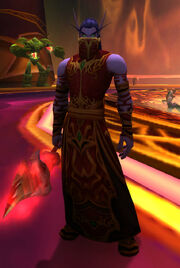mNo edit summary |
mNo edit summary |
||
| Line 10: | Line 10: | ||
{{WC3-inline}} [[Priest (Warcraft III)|Priest]], [[Sorceress]], [[Spell breaker]], [[Blood mage]]<br> |
{{WC3-inline}} [[Priest (Warcraft III)|Priest]], [[Sorceress]], [[Spell breaker]], [[Blood mage]]<br> |
||
{{RPG-inline}} [[Scout]], [[Warrior]], [[Felsworn]], [[Ranger]], [[Demon hunter]], [[Necromancer]], [[elven druid|Druid]]<br> |
{{RPG-inline}} [[Scout]], [[Warrior]], [[Felsworn]], [[Ranger]], [[Demon hunter]], [[Necromancer]], [[elven druid|Druid]]<br> |
||
| − | + | Nethermancer, Astromancer, [[Star Scryer]]<br> |
|
| mount = [[Hawkstrider]], [[Dragonhawk]] |
| mount = [[Hawkstrider]], [[Dragonhawk]] |
||
| homeworld = [[Azeroth (world)|Azeroth]] |
| homeworld = [[Azeroth (world)|Azeroth]] |
||
Revision as of 20:37, 27 October 2014
| Core races | |||
| Allied races | |||
- For playable blood elves, see blood elf (playable).
| Blood elves | |
|---|---|
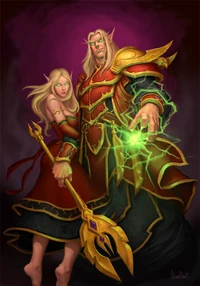 Artwork of a pair of blood elves by Glenn Rane | |
| Faction/Affiliation | Quel'Thalas, Horde, Illidan's forces, Burning Legion, Scryers, Shattered Sun Offensive, Argent Crusade, Darkmoon Faire, Independent |
| Character classes |
|
| Racial capital | Silvermoon City |
| Racial leader(s) | |
| Racial mount | Hawkstrider, Dragonhawk |
| Homeworld | Azeroth |
| Language(s) | Thalassian |
- "We must put this misery behind us. We must enter a new chapter! And so I say to you that, as of this day, we are no longer high elves! In honor of the blood that was shed throughout this kingdom, in honor of the sacrifices of our brothers and sisters, our parents, and our children, in honor of Anasterian... as of this day we will take the name of our royal lineage! As of this day, we are sin'dorei! For Quel'Thalas!"[1]
- — Kael'thas Sunstrider proclaims the rise of the blood elves
The blood elves, sin'dorei [ˈsiːndɔraɪ], [siːnˈdɔraɪ] or [siːndɔreɪ] in Thalassian ("children of the blood"), are an elven race native to Azeroth, hailing from the ancient elven kingdom of Quel'Thalas.[2] Their moniker is the cultural identity that the vast majority (approximately 90%) of the surviving high elves took up following the Third War.[3]
For nearly 7,000 years, high elven society centered on the sacred Sunwell, a magical fount that was created using a vial of pure arcane energy from the first Well of Eternity. Nourished and strengthened by the Sunwell’s potent energies, the high elves’ enchanted kingdom of Quel'Thalas prospered within the verdant forests north of Lordaeron. During the Third War, however, the high elves were nearly scoured from Azeroth. Led by the death knight Arthas, a Scourge army stormed into Quel'Thalas, slaughtering almost ninety percent of the kingdom’s population. Arthas then used the mystical Sunwell to resurrect the fallen necromancer Kel'Thuzad, irrevocably tainting the fount in the process. Prince Kael'thas Sunstrider rushed to his homeland's aid, and the survivors of the onslaught were renamed the "blood elves" in honor of their fallen people, their slain monarch, their annihilated Sunwell, and their ravaged kingdom.[3] Soon thereafter, the elves came under the merciless sway of withdrawal, and desperately sought to relieve it. To this end, Kael'thas commanded the great ranger Lor'themar Theron (who had assumed temporary leadership of the high elves prior to Kael's return)[3] and the new Ranger-general of Silvermoon, Halduron Brightwing, to safeguard the elven homeland, while Kael'thas himself went to battle alongside the New Alliance—and later, Illidan Stormrage.
The blood elves succeeded in retaking much of their homeland, coming under the regency of Lor'themar Theron in the prince's absence. Kael'thas had assured his people that one day he would return to Quel'Thalas and lead them to paradise, yet time revealed that his promises were nothing more than lies. On Outland, the prince became twisted due to his reliance on fel energy, the dark and corrupting essence wielded by the demonic Burning Legion itself. Unbeknownst to Illidan, Kael'thas also came under the sway of the Legion's commander, Kil'jaeden. The prince ultimately returned to Quel'Thalas, seeking to usher his new master into Azeroth through the defiled Sunwell, though was killed for his treachery before his cataclysmic ambitions could be fulfilled. The draenei prophet, Velen, then used the essence of a darkened naaru to restore the Sunwell as a fount of both arcane and holy energy.
Inspired by the Sunwell's rebirth, the blood elves have since entered into a shining new era in their ancient race's history. Although some elves remain hesitant to abandon their dependence on arcane magic, others have embraced change for the betterment of Quel'Thalas. Yet only time will tell if the blood elves can avoid repeating the tragic mistakes of their past.[2]
Introduction
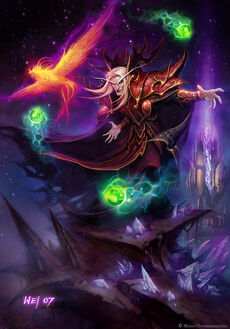
Prince Kael'thas Sunstrider, Lord of the blood elves.
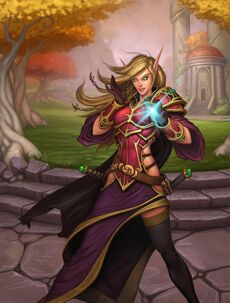
"Magic is the birthright of every citizen. We are all embraced by the Sunwell."[4]
Those now known as blood elves were once high elves. With the great power and protection of the Sunwell at their beck and call, the elven kingdom of Quel'Thalas thrived for a strong 7000 years. Masters of magic, and with a natural affinity for wielding it, the high elves championed the belief that they were the "sun blessed." They basked in the Sunwell's might, using it much like the Highborne they descended from used the Well of Eternity. Life for the high elves changed during the Third War, when King Arthas' Scourge attacked Quel'Thalas and shattered the elven race. The Scourge slew more than 90% of the high elven population, devastating their culture, and slaying King Anasterian Sunstrider. His son and heir, Prince Kael'thas Sunstrider, was thankfully studying magic in Dalaran at the time of the disaster and quickly rushed to his people's aid. He returned to find Quel'Thalas in ruins, and thirsting for vengeance, gathered the survivors and renamed them "blood elves" in honor of their fallen kin. Prior to the Sunwell's destruction, all high elves were constantly bathed in its magical power. Now bereft of this arcane energy, the elves of Quel'Thalas suffered from their withdrawals. Kael'thas worried that they would soon die without another magical source to replace the Sunwell. The blood elves therefore set about learning to drain magic from alternative sources.
Soon, the blood elves clashed with the Scourge and the Amani trolls, who were making inroads into former elven territory. Lor'themar Theron was commanded to watch over the shattered elven kingdom and look to finding a cure for their addiction, while Kael'thas took a group of the strongest blood elf warriors and spellcasters and joined the New Alliance against the Scourge. They were eager to avenge themselves on the undead forces; however, bigotry on the part of the Alliance's commander prevented the human forces from fully utilizing the aid the blood elves could bring to their fight. Due to Grand Marshal Garithos' prejudices, Kael'thas was forced to accept the assistance of Lady Vashj, and her reptilian Naga. When the humans discovered that the blood elves were working with the naga, they were imprisoned and sentenced to death by Garithos, for "conspiring with the enemy". However Kael'thas and his soldiers escaped the prisons of Dalaran with the aid of the naga, who told Kael about Illidan Stormrage, and the possibility of his knowing a way to help the Blood Elves with their magical addiction. This group of blood elves then helped defeat the demon Magtheridon and claimed his Black Citadel as their own.
In exchange for the blood elves' loyal service, Illidan gave them a place to live, as well as further techniques to siphon mana from anything with arcane power. Blood elves in Outland now hunt demons and feed off their magic. As a consequence, they started to undergo slight demonic tainting, starting with a change to their eyes, shifting from the arcane blue of a high elf to the fel green most blood elves now have. Not every blood elf lives in Outland. Most blood elves still live in Azeroth, particularly in Quel'Thalas. These blood elves seek to reclaim their lost homeland and destroy the Scourge at any cost.[5] The prince sent back a master magi named Rommath and several of his magisters, with a message of hope for the blood elves remaining in Quel'Thalas: That one day Kael'thas would return to lead his people to paradise. Rommath has made great progress in teaching the blood elves advanced techniques to manipulate arcane energies. With renewed purpose, the blood elves have now rebuilt the city of Silvermoon, though it is powered by volatile magics.[6] Emboldened by the promise of Kael'thas' return, the weary citizens of Quel'Thalas now focus on regaining their strength, even as they forge a new path into an uncertain future.[7]
History

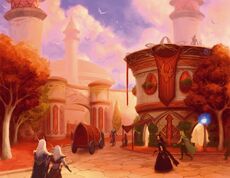
Silvermoon City, the ancient capital of the elven people.
Ten thousand years ago, during the reign of the night elf Queen Azshara, there was an elite magic-using sect known as the Highborne, who dabbled in magics that many other elves considered heretical by drawing upon the power of the Well of Eternity. Fiercely loyal to their queen, the Highborne opened a number of portals under her direction that brought forth the Burning Legion, triggering the War of the Ancients. Some time after the Great Sundering, most of the surviving Highborne were exiled from Kalimdor and settled in the eastern continent, founding the kingdom of Quel'Thalas. They became known as high elves. During this time, they created the Sunwell, and switched to a diurnal waking cycle. Their purple skin eventually faded to a pale peach color, like that of some humans and dwarves.
For the history of the high elves in the years between their exile and the Third War, see high elf.
During the Third War, Prince Arthas led his army of the Scourge against them, ravaging Quel'Thalas and corrupting the Sunwell. Despite the elves' best efforts, most of the high elven population were eradicated during this conflict. The elven scion, Kael'thas Sunstrider, quickly rushed to the aid of his homeland to rally the survivors. In remembrance of their fallen brethren, most of them renamed themselves the blood elves, or sin'dorei, and swore to avenge their fallen race. The Sunwell had become tainted with dark magic during the Scourge invasion, and Kael'thas destroyed it to avert another catastrophe - this dark power corrupting and killing the elves. Though he was successful in this regard, without the fount of power to sate them, the elves of Quel'Thalas suffered a withdrawal-based lethargy.[2]
Cut off from their source of power once again, the elves went into magic withdrawal. Desperate for aid following the Third War, the blood elves rejoined what was dubbed the "New Alliance." Kael'thas commanded Lor'themar Theron to safeguard the elven homeland, while Kael himself took 15% of the blood elven race (including some of his most powerful and gifted magisters) to join with the Alliance fighting in the equally destroyed Lordaeron. However, this tenuous alliance would not last, and the blood elves came under the bigoted scrutiny of one Grand Marshal Garithos. Garithos, a human supremacist, consistently gave the blood elves either meager tasks beneath their capabilities, or worse, suicidal missions devoid of reinforcements, in order to rid himself of the sin'dorei.[8]
The towering spires and lush forests of Quel'Thalas, the elven homeland.
Kael'thas and his forces were offered aid from an unlikely source - the naga under Lady Vashj, who shared a common ancestry with the elves and a common enemy in the Scourge. Out of options, Kael warily accepted her aid, though Garithos scapegoated this decision to put the entire blood elven contingent to death in the Dungeons of Dalaran. Viewing this as outright betrayal, Kael'thas was not so reluctant to accept Vashj's aid again when she offered to assist his escape.

A blood elf by Glenn Rane. Notice the magical runes around his left eye.
Prince Kael'thas led his followers to freedom, to the extra dimensional wastes of Outland, the remnants of Draenor, and pledged allegiance to Illidan who promised to grant them a new source of magic by teaching them to siphon magic from powerful alternative sources, including demons. Together with their allies the naga, Illidan led the blood elves to conquer Outland, gaining in the process the friendship of the nearly extinct Broken. The blood elves then followed Illidan to the Icecrown Glacier in an attempt to destroy the Lich King; however, they were defeated by Arthas, who wounded Illidan, forcing the blood elves and naga to retreat, allowing Arthas to ascend the glacier and merge with the Lich King. During the battles in Northrend, several of the deceased blood elves (including the powerful bearer of Quel'Delar, Lana'thel) were raised into undeath by Arthas, to serve him as his "San'layn."
Back in Quel'Thalas, the blood elves under Lor'themar Theron and Halduron Brightwing were undergoing their own tribulations. Retaking their homeland seemed a daunting task, as the Scourge was still occupying it in large numbers. The essence of the Sunwell, a woman named Anveena Teague, was kidnapped by the great traitor Dar'Khan Drathir (who had sold his people out to Arthas during the Scourge invasion) and brought to Quel'Thalas. Lor'themar attempted to avenge the Sunwell's destruction by killing Dar'Khan, though was unsuccessful in the face of his dark magics. The blood elves ultimately allied with the blue dragon Kalecgos and his companions, and succeeded in eliminating Dar'Khan for the time being. Lor'themar put Anveena under sin'dorei protection, her status as the Sunwell's mortal avatar to be kept a closely guarded secret.
As things looked bleak, however, Kael'thas sent back Grand Magister Rommath and a group of magisters to Quel'Thalas, to spread Illidan's teachings (said teachings Rommath smoothly attributed to Kael) and to reclaim Quel'Thalas with their colossally powerful magic. Invigorated by the formidable new techniques at their disposal, such as forcibly taking the magic and power of arcane-bearing sentient creatures, the blood elves were able to retake much of Quel'Thalas and even restore much of Silvermoon City. The remaining Scourge proved little match for Rommath and the magisters, who quickly went about destroying them and rebuilding the city "almost overnight." Emboldened by the notion of the prince's promised return to lead his people to power and glory, the blood elves began to focus on regaining all of their homeland and their strength to this end.[3]
Around this time, the emerald blood elven eye glint came to prevalence: elves in both Outland and Quel'Thalas found themselves exposed to fel magic, courtesy of those who were actively dabbling in the substance. The prince's relatively quick acceptance of dire measures (e.g., draining magic from demons) is by no means characteristic of blood elves in general. The blood elves of Outland have by now discovered Kael'thas' agreement with Illidan, and they have for the most part become convinced of its necessity. Most blood elves still live on Azeroth, though. Few of these elves know of Kael'thas' pact with Illidan, and many would be horrified if they discovered it. Draining magic from small mana-bearing vermin is a far cry from draining magic from demons. Yet, as their hunger grows, blood elves--particularly those in Outland--are becoming increasingly inured to the things they must do in order to obtain more magic. For the blood elves of Azeroth, a lot of their architecture and culture were dependent on magic, with the Sunwell being the source of that magic. With the Sunwell destroyed, the architecture that was being held together by its magic started to fall apart. Without the Sunwell's magic to maintain Silvermoon, half of Silvermoon became completely abandoned and run down. The buildings that they occupied: those that remain standing and in pristine order, is now using demonic energies to maintain the architectural structures.[6] Indeed, it seems that fel energy was one of the "volatile magics" used to rebuild Silvermoon. Not even the most pious of priests or the most reverent of Farstriders were spared from natural exposure to it, as mere proximity to a degree of fel magic leads to the taint. Like the orcs before them, high elves bear a physical marking from this exposure -- the eyes.[9]
The blood elves, now under the official regency of Lor'themar Theron in the absence of Kael'thas, looked to finding new allies. This initially came to pass in a strange incarnation: the Forsaken of Lordaeron, who offered aid and support to the bewildered and overstretched sin'dorei.
The Forsaken have been working closely with the blood elves to purge the greater phalanxes of Scourge presence from the Ghostlands since their induction. Lor'themar Theron was Sylvanas Windrunner's second in command during the Second Battle of Quel'Thalas, and many Forsaken were high elves culled from the same battle. The aid provided by the Forsaken has included reinforcements, a number of outposts in and around the reclaimed blood elf territories, and a teleportation device between the Undercity and Silvermoon.
The Burning Crusade

The sin'dorei were able to reclaim much of Quel'Thalas, coming under the leadership of Regent Lord Lor'themar Theron, Ranger General Halduron Brightwing, and Grand Magister Rommath. However, new trials appeared on the horizon: the technique of taking magic from other beings resulted in the birth of the "Wretched," a small offshoot of undead-esque, disorganized magical addicts who were unable to keep their withdrawal in check. Their presence became a reminder to the blood elves of the importance of controlling their magical addiction - for if they do not, it will control them. Blood elven adventurers went about putting down a number of the small pockets of Wretched lingering in Eversong.
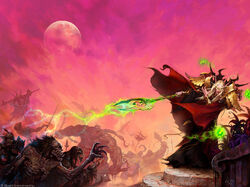
Varanis Bitterstar fighting the undead Scourge.
The blood elves were caught in the throes of constant combat: with the Scourge presence emanating from Deatholme on one hand, and continued raids and attacks coming from the Amani trolls, who maintain their own holdings within the ruins and ziggurats of Zul'Aman on the other. The former threat was ultimately neutralized, thanks to the combined efforts of the sin'dorei Magisters and Farstriders, along with support from the Forsaken. Under direction from leaders within the Ghostlands, this culminated with the eventual battle with and demise of the Scourge leader, Dar'Khan Drathir, whose head was sent to Regent Lord Lor'themar. Concurrent with failed negotiations with the Alliance, and night elven incursions into Quel'Thalas, Lor'themar began to forge an alliance with the faction his Forsaken allies now belonged to: the Horde. Several ambassadors were sent to and from Silvermoon, and Dar'Khan's death allowed the blood elves to take an equal seat at Warchief Thrall's political table. Thus, the blood elves were officially accepted into the Horde.
With that, Quel'Thalas began to find its footing once again. Rommath and the magisters quickly went about silencing any dissidents speaking against the new direction Silvermoon was taking, and the blood elves enforced what bordered on a totalitarian police state to better keep their people united. With the goal of joining with Prince Kael'thas on the agenda, several blood elves began undertaking pilgrimages to the shattered world of Outland. However, what they expected to find was a far cry from the trials and revelations that awaited them.

The Silvermoon City emblem, the metaphorical rising phoenix.
Meanwhile, the blood elves in Outland under Prince Kael'thas dispersed -- most, such as the powerful Sunfury forces, remained with the prince, and took over the mana-rich area of Netherstorm. Others, such as the Eclipsion, travelled to serve Illidan Stormrage's ambitions in Shadowmoon Valley. Several were trained as demon hunters, though the success rate of this training was mixed.

A blood elf paladin.
Under Kael'thas' direction, the blood elves attacked the citadel of Tempest Keep. Slaughtering its defenders and causing the outmanned draenei to flee in their vessel, Kael'thas finally found himself dealing with an odd sight: a naaru, named M'uru, who proved to be the Keep's final defender. After some hassle, Kael'thas was able to overcome it, claiming Tempest Keep as his own, and sent the subdued naaru back to Quel'Thalas as a gift for his people to feed upon. This decision led to the creation of the Blood Knights, a powerful order of paladins wielding light stolen from the Naaru's being. Back in Quel'Thalas, the coming to power of this order was met with mixed reactions - many citizens viewed them as staunch and iron defenders of Quel'Thalas, though others (such as the Farstriders) looked down upon their modus operandi.
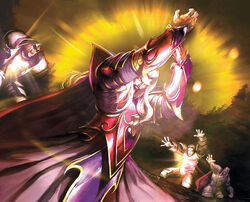
A blood elf unleashing  [Arcane Torrent].
[Arcane Torrent].
During this time, Kael'thas underwent a change that would have dire consequences. Outing Illidan as an inefficient leader, Kael sold his loyalties to Kil'jaeden and the Burning Legion. In secret, he began harvesting the great power coursing through Netherstorm, and his judgement -- and actions -- became increasingly callous. After ordering the slaughter of the Kirin'Var Village, Kael sent a raid of blood elves under Voren'thal the Seer to attack Shattrath City. However, Voren'thal and his followers surrendered to the Sha'tar, and betrayed the twisted prince, forming the Scryers in order to oppose him. Though met with an icy reception by the draenei residents of the city, culmitively named the Aldor, the Scryers were granted their own sin'dorei-themed portion of Shattrath. From here, they began to fight back against Kael'thas, and sent numerous agents back to Netherstorm and Shadowmoon Valley.
Back in Quel'Thalas, antagonists from the past reemerged. The troll warlord Zul'jin, still embittered by the orcs' swift abandonment of their siege of the elves' high home during the Second War (and the New Horde's subsequent acceptance of the same elves into their ranks), turned against his former allies. Within the walled fortress of Zul'Aman, largely untouched by the Scourge onslaught, Zul'jin directed the Hex Lord Malacrass to infuse the spirits of ancient animal gods into living troll warriors. Once again, the fearsome troll army was defeated, Zul'jin himself killed in the conflict. The sin'dorei would not be troubled again by their old enemy for years to come.[10]
The blood elves in Quel'Thalas thus began their travels into Outland, urging their Horde allies (whom both Regent Lord Lor'themar and Grand Magister Rommath had enticed with the notion of uncorrupted orcs still holding a presence there)[11] to do so too.[10] However, what awaited them was not the paradise that was promised, but the barren wasteland of Hellfire. After dismantling his presence in Netherstorm, Kael's switch of allegiance was uncovered by the Scryers, and the prince himself was cornered in Tempest Keep. He was defeated, left for dead, though clinging to life. Kael'thas appeared before the leader of the Sha'tar, the naaru A'dal, and berated him for not finishing the job. Announcing his loyalties to all those present, Kael'thas resolved to usher Kil'jaeden into Azeroth.
Kael'thas returned to Quel'Thalas, and briefly attacked Silvermoon City with his felblood minions. Retaking M'uru from its chambers, Kael'thas set the stage for his final stand on the Isle of Quel'Danas. He also spirited Anveena away from her undisclosed location in Quel'Thalas. Lady Liadrin, the Blood Knight Matriarch, witnessed this attack on Silvermoon herself - and now without a power source for the Blood Knights, travelled to Shattrath to meet with A'dal. She learned that M'uru had resigned himself to this fate a long time ago, and pledged the blades of the Blood Knights to ending the prince's dark ambitions, and restoring Silvermoon to its glory. The Shattered Sun Offensive, a coalition of the Scryers' blood elves and the Aldor's draenei, marched to liberate Quel'Danas. Prior to this turn of events, the prophet Velen foretold the revelations to come, intricately tied to the sin'dorei and their fate:
- A'dal says: 'Silvery moon, washed in blood,'
- A'dal says: 'Led astray into the night, armed with sword of broken Light.'
- A'dal says: 'Broken, then betrayed by one, standing there bestride the sun.'
- A'dal says: 'At darkest hour, redemption comes, in knightly lady sworn to blood.'
Kael'thas made his final stand in the Magisters' Terrace, little more than a shadow of his former being - a Wretched himself. He was cut down, and the Shattered Sun Offensive took the battle to the blood elves' Sunwell - now occupied by the most powerful blood elves under Kael's command, the Shadowsword, allowed to gorge themselves upon unlimited fel-power - becoming a demon hybrid in the process, reinforced by the Burning Legion's demons.
Ultimately, the Shattered Sun Offensive relieved the Sunwell from the Burning Legion, and even banished Kil'jaeden back to the Twisting Nether.
A Wretched Kael'thas and Kil'jaeden the Deceiver in the Sunwell Plateau.
The Sunwell restored
After the encounter involving Kil'jaeden, it appeared that the Sunwell's powers were exhausted due to Anveena sacrificing herself, banishing Kil'jaeden back to the Twisting Nether; however, Prophet Velen and Lady Liadrin appeared to the scene shortly afterwards. Velen dropped M'uru's small flickering "spark" into the Sunwell and, with that, a huge pillar of light emerged from the Sunwell, at which Velen responded: "In time, the light and hope within,[sic] will rebirth more than this mere fount of power... Mayhap - they will rebirth the soul of a nation."
With the Sunwell's rebirth, the Blood Knights have engaged in a far more harmonious relationship with the Light, which they now channel directly through the Sunwell itself.[12] They have resolved to embrace their new source of power, as they forge for themselves a new identity as they lead their people into a more promising future.[10]
Quel'Thalas' interregnum

The Sunwell in its current state.
Following the dramatic events put into motion with the betrayal and death of Prince Kael'thas, the sin'dorei have endured - coming under the full leadership of Regent Lord Lor'themar Theron, who has resolved to see his people conquer their addiction completely. Rather than proclaim a new elven dynasty, Lor'themar has opted to retain his title of regent, despite being encouraged by both Halduron Brightwing and Grand Magister Rommath to take a more prestigious role. With no surviving members of the Sunstrider dynasty, Lor'themar has thus become the sole ruler of Quel'Thalas.
During this period, the blood elves have fortified the Isle of Quel'Danas, keeping it well guarded and not open to visitations. Halduron Brightwing now controls access to the revitalized Sunwell, and the sin'dorei remain ever vigilant. Lor'themar has attempted to mend bridges with his quel'dorei cousins, allowing them access to the sacred Sunwell and even offering a certain high elven lodge aid and supplies. These attempts have varied in success, the former making pilgrimages to Quel'Thalas and the latter outright declining any assistance.
The Sun King's shadow
Kael's decision to ally himself with the Burning Legion, attack Silvermoon City in an attempt to steal M'uru, and forcibly put the few pilgrims who reached Outland into harsh labour,[13] effectively severed the ties of loyalty to the twisted prince for all but the most damningly fanatical sin'dorei.[14] Following Kael'thas' demise, a number of the Sunfury forces have returned home to serve their people, rather than follow in Kael's increasingly dark path. Quel'Thalas has since branded Kael'thas a traitor, though the ramifications of this monumental betrayal has shaken its leadership to the core.[15]
Shortly after the reclamation of Quel'Danas, the Lich King turned his gaze towards conquest. Though Lor'themar was apprehensive to commit to another battle so soon after the events that transpired on Quel'Danas, with Sylvanas Windrunner's own brand of insistence the sin'dorei agreed to fight alongside their allies in a renewed Northrend campaign to finally end the Lich King and avenge Quel'Thalas.
Wrath of the Lich King
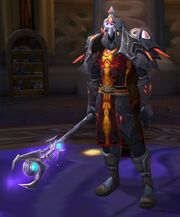
The blood elves accompanied the Horde advance into Northrend, to do battle with the Lich King. Archmage Aethas Sunreaver, a powerful blood elven member of the Council of Six, was instrumental in allowing the Horde a sanctuary in the magical city of Dalaran, and his followers, the Sunreavers, seek to have blood elves admitted as members of the Kirin Tor. The Sunreavers sent numerous battle-mages to the Horde capital cities, in order to allow their allies quick travel to Wintergrasp Fortress.

Lor'themar claims Quel'Delar from the Sunwell.
Eventually, the Argent Crusade acquired a foothold in Icecrown, and proclaimed the Argent Tournament open. The Sunreavers represented the Horde champions during the tournament, and several blood elves including the Blood Knight champion, Malithas Brightblade, fought during the spectacle. An ancient quel'dorei blade known as Quel'Delar was discovered sheathed in the snow outside the tournament grounds. Its owner, Thalorien Dawnseeker, had perished valiantly during the Scourge invasion, wielding the blade in defense of the Sunwell. It was later retrieved by Thalorien's good friend, Lana'thel, who accompanied Prince Kael'thas into Northrend, where she wielded Quel'Delar against Arthas himself. However, she was cut down, and raised into undeath. Now as the Blood-Queen of the San'layn, a fallen sect of blood elves from that fateful expedition now forced to serve Arthas' will, Lana'thel reappeared and shattered Quel'Delar in an effort to sever all ties of emotion to it. The onlooking elves swore to see it restored.
The journey to purify Quel'Delar of its Scourge taint would ultimately lead heroes to the Sunwell, where they are admitted entry once Ranger General Halduron Brightwing gives his permission. Within, Lor'themar Theron, Grand Magister Rommath, and Lady Liadrin are seen, along with Auric Sunchaser and groups of elven pilgrims. The purification of Quel'Delar - which varies from near-death for a non-blood elf and all-around praise for a sin'dorei - ends with the reforged blade taken back to Dalaran.
Blood-Queen Lana'thel and her San'layn minions would ultimately perish during the battle in Icecrown Citadel, and the Lich King himself would follow suit. At long last, the blood elves had achieved their goal of seeing the despoiler of Quel'Thalas fall.
Cataclysm
Though relatively unhurt by the Shattering, the blood elves of Quel'Thalas are still dealing with sating their addiction. With the encouragement of their Regent Lord, Lor'themar Theron, and the renewed Sunwell's holy energy, a great number of the sin'dorei have resolved to overcome the magical addiction that had plagued their race, though some are still hesitant to abandon their dependence on arcane magic. Over time, the Sunwell's Light could cure the blood elves of their cursed state, but some still cling to the arcane powers they procured and are hesitant to relinquish them. As ever, the sin'dorei fight to protect Quel'Thalas, and to help redeem the soul of their ancient people.[16]

Halduron and the Farstriders in the Ghostlands.

Lor'themar Theron, Halduron Brightwing, and Grand Magister Rommath preside over Quel'Thalas from Sunfury Spire.
The blood elves seem to have generally accepted Lor'themar Theron's rule in the apparent absence of surviving royalty, or after the last scion's great betrayal. Lor'themar, who had weathered many of the kingdom's darkest days, fittingly will be the one to lead his people into a prosperous future.[2]
Under the leadership of High Examiner Tae'thelan Bloodwatcher, an ancient order known as The Reliquary has resurfaced to support Quel'Thalas and its Horde allies. With the goal of acquiring powerful magical artifacts for the safekeeping, and to free the elves of their magical addiction for good, the agents of the Reliquary have established themselves as a force to be reckoned with. Tae'thelan's goal is somewhat similar to the stated ambition of the Blood Knight matriarch, Lady Liadrin, who has also resolved to see her people overcome the baneful addicition that had so weakened them in the absence of the restored Sunwell.[17] The Reliquary hold a presence in various zones, including the Badlands, the Blasted Lands, Uldaman and at least some degree of Uldum.
Because their expulsion from night elf society after the War of the Ancients was due to their use of arcane magic, the blood elves were outraged to hear that the kaldorei had welcomed the Highborne back and were tolerating the practice of arcane magic again. After witnessing the "rookie" mistakes made by the new kaldorei magi, however, the blood elves are anxiously awaiting whatever mess the kaldorei are going to put themselves in.[18]
A number of the blood elves seem to have taken on a more active role within the wider Horde following the shattering. Garrosh Hellscream himself holds court with several representatives of Silvermoon, and the Blood Knight Master Pyreanor is referred to as one of Warchief Hellscream's personal advisors. Envoy Sheelah and Guardian Menerin were sent to Ashenvale to support the Warsong Clan, though enemy agents were able to interrupt their plans. Several sin'dorei have carved out a considerable rank in the army sent to conquer the Stonetalon Mountains, such as General Salaman, Spy-Mistress Anara, and Master Assassin Kel'istra. Subjugator Devo gains the loyalty of the Boulderslide Kobolds, and uses them to reinforce Overlord Krom'gar's forces against the Alliance. Following the death of Furien at the hands of the Alliance in Desolace, his bereaved sister Cerelia goes about claiming vengeance - culminating in the eradication of Nijel's Point.[19] In Azshara, several blood elves are found learning more about their heritage from the ancient elven ruins. Andorel Sunsworn coordinates the forced removal of the lingering night elves in the area.
A retelling of elven history concerning the ![]() [Crystal of Zin-Malor] can be undertaken in Winterspring, addressing the intertwining plights of the Highborne, their fallen quel'dorei descendants, and the recent venture of a Farstrider regiment, all of whom met their end on the icy shores of Lake Kel'Theril. Their stories are told through three lingering spirits: the Kaldorei Spirit, the Quel'dorei Spirit, and the Sin'dorei Spirit. Ever-tempted by the promises of power, numerous Highborne fell to the curse of Zin-Malor, their spirits still bound to Kel'Theril. Years later, the quel'dorei were drawn to the mysterious fates that befell their ancestors at Kel'Theril, though their leader was consumed by his obsession with Zin-Malor -- an undertaking that would lead to the deaths of himself and his comrades. After his people had risen as the blood elves, a Farstrider excursion sought to uncover the secrets of Zin-Malor. Driven and cunning, determined not to use the crystal of Zin-Malor themselves, the blood elves would soon find their preparations to be in vain: it warped them into Wretched regardless of their caution.[20] Adventurers are tasked with uncovering the truth of Zin-Malor and its effect on the elves.
[Crystal of Zin-Malor] can be undertaken in Winterspring, addressing the intertwining plights of the Highborne, their fallen quel'dorei descendants, and the recent venture of a Farstrider regiment, all of whom met their end on the icy shores of Lake Kel'Theril. Their stories are told through three lingering spirits: the Kaldorei Spirit, the Quel'dorei Spirit, and the Sin'dorei Spirit. Ever-tempted by the promises of power, numerous Highborne fell to the curse of Zin-Malor, their spirits still bound to Kel'Theril. Years later, the quel'dorei were drawn to the mysterious fates that befell their ancestors at Kel'Theril, though their leader was consumed by his obsession with Zin-Malor -- an undertaking that would lead to the deaths of himself and his comrades. After his people had risen as the blood elves, a Farstrider excursion sought to uncover the secrets of Zin-Malor. Driven and cunning, determined not to use the crystal of Zin-Malor themselves, the blood elves would soon find their preparations to be in vain: it warped them into Wretched regardless of their caution.[20] Adventurers are tasked with uncovering the truth of Zin-Malor and its effect on the elves.
Ranger General Halduron Brightwing and a regiment of Farstriders are found on the outskirts of Zul'Aman, securing the area and conversing with both the Darkspear Chieftain, Vol'jin, and Vereesa Windrunner. With the threat of a new troll empire brewing within Zul'Aman, the Ranger General has called upon the support Vereesa could offer, to which she gladly accepted, though Lor'themar Theron is less than pleased with this decision.
Post-Cataclysm
With the war between the Horde and Alliance reaching boiling levels, Warchief Garrosh Hellscream has sought to make his expansionist dreams a reality, beginning (but not ending) with Theramore Isle. The blood elves are viewed as an essential part of the Horde, due in part to their considerable technological advancement, particularly their fearsome mana bomb technology.
Lor'themar Theron appears to have distanced himself from the thumb of Sylvanas Windrunner in recent times, in contrast to his almost subservient attitude post-Quel'Danas. Instead, he has gained favour and respect from Garrosh Hellscream, while keeping himself at a safe distance from the Warchief, too. The regent lord has stated that the blood elves are loyal to the Horde, and that loyalty to Garrosh, being its leader, is a result of that, not the cause. Lor'themar and Halduron decide to send Kelantir Bloodblade and two ships of sin'dorei warriors to fight in Garrosh's war against Theramore, though Kelantir is ultimately assassinated after gravitating more towards the views of Vol'jin and Baine Bloodhoof, openly questioning Garrosh's methods.

Grand Magister Rommath and Archmage Aethas Sunreaver prepare to escape Dalaran.
The blood elves of Dalaran, now an official part of the Kirin Tor after the Sunreavers' successful efforts to have them readmitted as members, find themselves undergoing their own intrigues: Aethas and Rhonin choose to allow a contingent of Kirin Tor magi to aid Theramore as a deterrent, though the mage the two nominate for the task -- Thalen Songweaver -- is revealed to be Garrosh's spy, with knowledge of the theft of the Focusing Iris. A mana bomb, augmented by the power of the iris, is dropped over Theramore, utterly annihilating it. Thalen's treachery is a blow to the Suneavers' credibility, and Aethas's cause in particular. Later, Aethas supports Jaina as the new leader of the Kirin Tor.
Mists of Pandaria
Blood elven history can be seen on the isle of Pandaria, during the Quest:Family Tree quest. Lorewalker Cho makes several observations as he views figures of the blood elves, their high elven forefathers, and their night elven ancestors, taking special note of the suffering the race had gone through in recent times, the reason behind the blood elves' moniker, the great power the race wields, and the burdens that had come with it.
Landfall
The blood elves arrive in force to Pandaria, Regent Lord Theron himself leading a retinue of rangers, Sunfury, Blood Knights to the scene. The Reliquary has also been deployed, dispersing to uncover secrets long-hidden on the continent. Relations between the sin'dorei and the Horde become strained due to multiple instances of the blood elves' welfare being disregarded by the Warchief Garrosh, culminating in Lor'themar contemplating pulling Quel'Thalas out of the Horde, and rejoining the Alliance. As Lor'themar and Varian Wrynn begin talks to this end, however, the Sunreavers (whose ranks included agents of Garrosh Hellscream willing to risk their neutrality for his sake) are violently expelled from Dalaran by Jaina Proudmoore, who declares it for the Alliance. In retaliation, Grand Magister Rommath assaults Dalaran in an effort to rescue Aethas and the Sunreavers. He succeeds in his mission, coming to the aid of many wounded Sunreavers, forewarning those unaware of the danger, and freeing Aethas himself from the Violet Citadel. In the aftermath of this, the Sunreavers come to hold Garrosh as responsible for their removal from Dalaran as Jaina herself.
Though Jaina's purge puts an end to the talks between Theron and King Wrynn (and forces the sin'dorei back to Hellscream's Horde), Lor'themar is incensed at Garrosh regardless, and relations between them break down. Lor'themar orders Halduron and Rommath to assemble the rangers and magi, and states that the time had come for the sin'dorei to take matters into their own hands.
The Thunder King
Lor'themar created and led the Sunreaver Onslaught, which gathers members from all different forces of Silvermoon: the blood knights, the spellbreakers, the farstriders, the magisters, the reliquary and obviously the sunreavers. The assault is directed on the Isle of Thunder, their goal is to recoup all useful titanic artefacts from the mogu in order to guarantee their survival during the Horde's crisis. Also, they counteract the Thunder King and this zandalari allies. During the conquest, they often confronted the Kirin Tor Offensive.
The blood elves came on three destroyers and succeeded in the construction of a base on Isle of Thunder thanks to Scout Captain Elsia[21], naming it Dawnseeker Promontory in honor of Thalorien Dawnseeker. The war raged and the blood elves, led by Lor'themar on the front, broke the wall of the fortress.[22]. With the Shado-Pan Assault, they took the Thunder Forges [23] and tried to prevent the resurrection of Nalak, while [24] confronting their alliance counterpart directly. Ultimately, they took the anima of the Dark Animus [25] in the Throne of Thunder, which is now being analysed by Aethas.
Siege of Orgrimmar
Led by Lor'themar, the blood elves sailed from Pandaria to Durotar to help both Vol'jin's rebellion and most of the Alliance in their conquest against Garrosh. They helped take control of Bladefist Bay and made contact with Vol'jin. With the combined forces, Garrosh was ultimately defeated.
Warlords of Draenor
The Blood Knights will play a role during the upcoming expansion, bringing their understanding of the Light and the origin of paladins full circle from The Burning Crusade.[26]
Physical appearance
Firewarden Wyland Kaslinth, a blood elf mage.
Blood elves are biologically and physiologically high elves.[3] Courtesy of their exposure to fel magic (the practice of which spread in a similar fashion to the orcs own exposure to the substance, tainting even those in its proximity who chose not to dabble in it), the eyes of the sin'dorei now produce an emerald glow. They typically have fairly long hair, generally do not grow their facial hair to gigantic proportions until old age, and generally stand slightly taller than their human gender counterparts. As a general rule, blood elves are also slim, athletic, strong, and graceful. Furthermore, they all have large pointed ears that tend to be greeted with admiration (or mockery) by other races.[27]
Blood elves are 5-6 feet tall.[28] Blood elven males typically have slender, muscular, and athletic bodies. They also possess long pointy ears, acute senses and keen sight in the darkness. Night elves have long, slanted ears while blood elves' ears are shorter and tend to point upwards. Blood elven females can possess much the same, albeit typically sporting a slim elven physique. Like all elves, blood elves are considered highly attractive by the standards of most mortal races.[29] The sin'dorei are the favored humanoid form of the Red Dragonflight.[30]
Recently, those blood elves which were most loyal to Kael'thas Sunstrider have been gifted by Kil'jaeden with the privilege of engorging themselves on copious amounts of demonic blood, seemingly hastening their demonic evolution into what have come to be known as felblood elves, developing a variety of demonic traits in the process. Those blood elves and high elves who succumb to their magical addiction and descend into madness are counted among the Wretched.
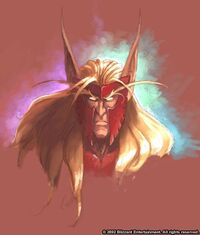
Prior to TBC, blood elves were depicted without glowing green eyes.
Whether the minor physical differences between a blood and high elf (the emerald eyes) persists through generations via genetics is unclear. A number of blood elf children are seen in-game, all of which brandish the green eye glint, though whether they were born before the Scourge onslaught or after (simply being born with it) is unknown.
Ultimately, it is a matter of time before the fel-power induced green glint reverts back to the blood elves' regular high elven eyes. This process, however, may take a fairly long time.[18]
Eyes
Although WoW portrays almost all blood elves with green eyes, they have been shown different in some sources:
In The Frozen Throne, blood elven eyes were depicted white and pupil-less, both in-game and in official artwork. A possible explanation for this is that when the blood elves first began to feed on demonic magic, it took a while for their eyes to change to the green they are known for today. However, since they were deprived of the magic of the Sunwell their eyes lost their blue hue and became white. This is probably false though, since when Valeera Sanguinar absorbed the magic of a naga Sea Witch's trident, her eyes instantly turned purple, the color of the magic in the trident. Similarly an official art piece by Red Knuckle showed a Blood Elf with Purple eyes due to his warlock powers.[31] This is backed up by more artwork of a blood elf warlock in the TCG.[32] A blood elven priestess is also shown with glowing yellow eyes, which could have occurred due to her practicing of the Light.[33]

A CGI representation of a blood elf priestess.
In classic World of Warcraft, blood elves had normal white eyes with pupils. The Sunwell Trilogy also depicted them with this appearance. A possible explanation is that all blood elves having green eyes in World of Warcraft: The Burning Crusade is simply an exaggeration by Blizzard to help differentiate blood and high elf NPCs, or it's simply a mistake or retcon by Blizzard.
The only thing that supports the theory of Blizzard planned Blood Elves to have glowing green eyes all along is the Priest unit in Warcraft III The Frozen Throne. These units have glowing green eyed models, but before the expansion (in Reign of Chaos) the Priest unit had glowing blue eyes.
Blood elves' eyes are well-attuned to the dark and "pierce the gloom," a trait they thank their night elven ancestry for. Blood elves can visually identify the hue of arcane energy around objects or people,[1] as well as the ebb and flow of such magic.[34]
Aging
Blood elves can potentially reach up to several thousand years of life.[27] It appears that physical maturation is roughly on par with human aging, as seen with several young elves (such as Valeera Sanguinar, who was a child during the Scourge invasion yet physically mature a few years later), though only up to a point. The aging process appears to even out at around their physical peak, before their aging becomes more sporadic and typically elven.
How fast they age precisely is unknown, but there is evidence of some sin'dorei being old enough to have existed since their exile from their kaldorei cousins. Anasterian Sunstrider, the High King of Quel'Thalas, was extremely long-lived, having presided over a number of long-standing conflicts and ruled Quel'Thalas for at least three thousand years. By this time, however, his physical appearance had become somewhat elderly, perhaps suggesting that typical blood/high elven old age is induced around that time period.
In addition to this, the blood elven engineers in the Secret Level Powerup tell Prince Kael'thas that they "built Dalaran's original defenses". Given that the events of the Secret Level Powerup take place in the Third War and the original defenses of Dalaran were erected almost 2700 years prior to this, this would lead us to assume that the engineers themselves were older than this. However, because of the fact the blood elven engineers only exist in a secret level, the extent of which they are canonical is debatable, as specified in their article.
Fel-power longevity
With the Sunwell restored, the close call the sin'dorei came to damnation appears to have been averted, the Sunwell itself now once again sustaining the blood elves' dependency on magic. As such, the blood elves ultimately did not mutate from their high elven appearance in the way their felblood offshoot suffered due to their addiction, and at this point it is simply a matter of time before the fel-power induced eyes revert back to their natural state.[18]
Culture
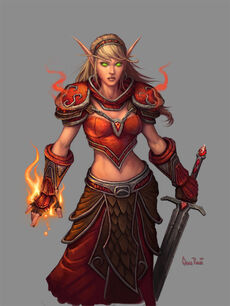
A sin'dorei blood mage by Glenn Rane.

Blood elven architecture
The term "blood elf" itself is a cultural identity: a show of respect and honor for the fall of the high elves, the destruction of the Sunwell, the near-annihilation of their kingdom, and their rebirth from its ashes.[3] As a culture, the sin'dorei have retained the look and feel of their fallen high elven kingdom, though have developed a greater penchant for the colour of crimson: the colour of their namesake. Crimson-red robes, decor and armour have become far more commonplace within blood elven society prior to the fall of the high elven people, a reference to the blood of their many brethren who had perished in the Third War.[35] The iconic and traditional blood elven colours are red, gold, and to a lesser extent, blue – all of which can be seen on their racial crest, the Icon of Blood.
Blood elven architecture is of the same illustrious and elegant design as it was when Dath'Remar Sunstrider founded the high elven kingdom in Quel'Thalas. It involves pendulous creations of wondrous curves and columns, its designs natural, floral, flowing, animal, and borrows much from the Art Nouveau style. Their fountains seem to defy physical boundaries, creating or warping water in impossible ways.
Blood elves have flags that feature a phoenix. In the Third War, blood mages had the ability to call phoenixes from the Elemental Plane of fire. These creatures appear to be deeply connected with the blood elves, possibly because they share a destructive nature, or perhaps due to their purely magical composition. This could allow the blood elves to have increased control over them. Since the phoenix dies and becomes reborn, it could be a symbol for the blood elves — the blood elves metaphorically 'died' as high elves and were reborn as blood elves, and as a more formidable people for the experience.[36]
In World of Warcraft, blood elf players speak Thalassian and Orcish.
Magical addiction
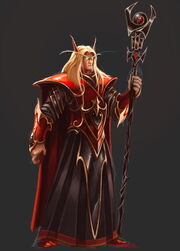
Blood elf warlock
Since the destruction of the Sunwell at the hands of Arthas and the Scourge, the blood elves have been forced to deal with the sudden relapse of their addiction to arcane energy. A constant curse since the original Well of Eternity was destroyed, the addiction has become more powerful than ever. Blood elves spend their waking days struggling with their weakness, seeking either to sate it by siphoning magical energy from their surroundings or to resist the urge to feed.
While the blood elves do not abstain from draining arcane power directly, they are careful to keep their addictions under control, keeping the power their new abilities offer while maintaining self-discipline. Those who lose control over their addiction change into Wretched, and invariably fall into insanity and corruption.
On several occasions after the Sunwell's defilement, Kael'thas publicly asserted that his people would die unless they found a new source of magic. There can be no doubt that withdrawal from prolonged exposure to arcane magic is a very unpleasant process: to this day it is not impossible that a high elf might choose to give in to the addiction and become one of the blood elves. Technically, though, the prince was mistaken. According to the top priests and medics on Azeroth, the only high elves who perished due to the Sunwell's loss were the very old, the very young, and elves who were already in poor health.
This is not to say, however, that withdrawal from magic would leave the elves unharmed. On the contrary, permanent mental or physical damage is possible.
Even so, the prince's relatively quick acceptance of dire measures (e.g., draining magic from demons) is by no means characteristic of blood elves in general. The blood elves of Outland have by now discovered Kael'thas' agreement with Illidan, and they have for the most part become convinced of its necessity. Most blood elves still live on Azeroth, though. Few of these elves know of Kael'thas' pact with Illidan, and many would be horrified if they discovered it. Draining magic from small mana-bearing vermin is a far cry from draining magic from demons. Yet, as their hunger grows, blood elves--particularly those in Outland--are becoming increasingly inured to the things they must do in order to obtain more magic.[3]
As Arcanist Helion (a starting zone quest NPC) says, "Control your thirst for magic... It is a thirst unending."[37]
Counteracting magic withdrawal
The elves had been sustained by the Sunwell for several millenia, during which time they had become dependent upon its power. The need to feed upon the arcane only became truly apparent after the Sunwell's destruction, when the elves were cut off from the constant flow of magic the well invoked.
Bereft of their Sunwell, the blood elves were forced to deal with their addiction elsewise. Through Illidan Stormrage (who maintained that magical addiction cannot be conquered by any means, only sated), Prince Kael'thas acquired the teachings of stripping arcane magic from other sources, be it mana-bearing items or creatures. This process was dubbed the "![]() [Mana Tap]," and became an important and increasingly essential part of the elves' lives. Kael instructed Rommath to spread these teachings back home in Quel'Thalas, as a way to sate -- but not cure -- the elves' addiction to magic. The knowledge was passed down until all blood elves had learned the techniques necessary to draw arcane energies from crystals, artifacts, creatures, or even mortals who commanded such power.[1] This technique was a cause of contention: some deemed it as immoral, while others callously overused it and were physically warped into what became known as the Wretched.
[Mana Tap]," and became an important and increasingly essential part of the elves' lives. Kael instructed Rommath to spread these teachings back home in Quel'Thalas, as a way to sate -- but not cure -- the elves' addiction to magic. The knowledge was passed down until all blood elves had learned the techniques necessary to draw arcane energies from crystals, artifacts, creatures, or even mortals who commanded such power.[1] This technique was a cause of contention: some deemed it as immoral, while others callously overused it and were physically warped into what became known as the Wretched.
Ultimately, the Sunwell was restored, now a mixture of both arcane and holy magic. With this inspiring turn of events, the elven addiction has - for the most part - begun to come back under control, as it was before the well's loss. With Regent Lord Lor'themar Theron's encouragement, the ability to sate their addiction conveniently via the Sunwell, and the plight of the Reliquary to free the elves of what remains of their addiction for good, the blood elves are on a far more efficient (and less dangerous) path to be free of their bane. However, a few elves remain enthralled by their former methods of gaining power, and are not eager to give up on them.[2]
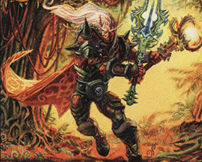
A blood elf warrior.
Classes
Silvermoon City Guardians standing vigil outside the royal palace of Silvermoon.
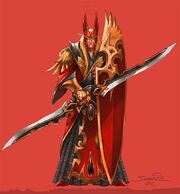
The blood elves have a considerable plethora of classes available: hunters (often representing Farstriders), mages (often representing Magisters), paladins (often representing Blood Knights), rogues, warlocks, warriors, priests, death knights and monks.
The Frozen Throne marked the debut of blood elven Blood Mages, Spellbreakers, priests and sorcerers, the latter two being the post-Third War incarnations of their high elven selves.
All of these classes can be seen in modern World of Warcraft to some degree; however, during Kael'thas's assault on the Isle of Quel'Danas, the formidable Spellbreakers' ranks were thinned drastically when their headquarters was overwhelmed by Kael'thas and his Burning Legion forces. The lone squad that remains now exists as a relic of a bygone era, as the Spellbreakers have refrained from training any new recruits since Kael'thas' betrayal.[18] That said, some time later, Lor'themar Theron himself ordered a revitalization of Spellbreaker training, leading to a resurgence of Spellbreakers among the blood elves' ranks.[38] Blood elves are also one of the two races to successfully complete demon hunter training, along with their night elven cousins.
The (now non-canon) roleplaying guide also lists a number of blood elven classes: the Scout, Felsworn, necromancer, and the druid. Though the scout and felsworn classes remain ambiguous (the former perhaps more of a circumstantial occupation than a class of its own in modern Warcraft), elves part of the Scourge have demonstrated the ability to become necromancers. The druid is an interesting case; blood elves such as High Botanist Freywinn have demonstrated the physical "ability" to become a conventional druid (albeit, in his case, not through conventional means), while the Warcraft II manual makes mention of elven druids creating certain Runestones.
Blood elves have at least one active lore character to represent most of their classes: Lor'themar and Halduron for hunters (and arguably warriors); Rommath, Tae'thelan and Aethas for mages; Liadrin for paladins (and arguably priests); Valeera for rogues; and Koltira for death knights. The exceptions are warlocks and monks.
Population
The Scourge invasion of Quel'Thalas ended with the slaughter of roughly 90% of the high elven people.[2] Following the Quel'dorei's decimation at the hands of the Scourge, Kael'thas rallied roughly 90% of the survivors, who took up the name "blood elf" in honor of their fallen brethren.[3]
Following the blood elves' abandonment of Garithos' "New Alliance," Kael'thas took 15% of the blood elven people to find and claim a new homeland in Outland, while the remaining 85% remained on Azeroth to reclaim Quel'Thalas from the Scourge.[3] After Kael'thas' defeat a number of the Sunfury returned to their brethren in Quel'Thalas.[15]
Beliefs and practices

The entrance to Silvermoon City, decorated by the phoenix of Quel'Thalas.
The blood elves (and high elves) venerate the metaphorical idea of the "sun" in their culture. They consider themselves the "sun-blessed," and have incorporated it into even their social greetings and farewells.[39] This reverence is the polar opposite belief of their night elven cousins, who hold the moon in a similarly high regard. This stems from elven society centering on the age-old Sunwell, which had empowered and protected Quel'Thalas and its citizens for a strong 7,000 years prior to its destruction.[2] Following the loss of the Sunwell, Quel'Thalas' citizens came to incorporate the notion of "remembrance" in honor of their fallen fount.
As high elves, several blood elves were members of the Church of the Light. Following their conversion to the sin'dorei, and utilizing less noble methods to sate their addiction, a number of the sin'dorei felt and believed that the light had abandoned them. One of the most prominent followers of this mindset was Lady Liadrin, who renounced her vows to the light due to this supposed abandonment. A disillusioned Liadrin and many of her followers would later use the light as a tool, forcibly taking it rather than relying on faith to wield it, though some blood elves remained faithful in the light's guidance and continued to wield it without resorting to these methods.[40] With the Sunwell restored, now a mixture of both holy and arcane power, it would appear that some sin'dorei - Liadrin in particular - have converted (or converted back) to its teachings. Others, however, are not so eager to abandon their old ways.[2]
The blood elven crest, seen on many banners, tabards, and buildings in and outside of Quel'Thalas, depicts a phoenix. Metaphorically, this represents the blood elves' "rebirth" from the ashes of their destroyed kingdom and brethren, sundered in the Third War, and as a more formidable people for having done so.[41]
There are many other beliefs and practices found within blood elf society, and a number of which have clashing ideals - such as the beliefs and policies of the Blood Knights and the Farstriders.
Symbolism
Prior to the Third War, the blood elves (then high elves) used a unicorn as their racial crest. Following the near-collapse of Quel'Thalas following the Scourge invasion, the newly-named blood elves incorporated a more fitting creature into their culture: a phoenix. The phoenix has since become the Sin'dorei's most iconic crest, found on their banners, their revised racial crest (the Icon of Blood), weaponry, buildings, tents, and many other sightings. Metaphorically, the nature of the phoenix represents their "rebirth" from the ashes of their sundered brethren, a sentiment also reflected by the blood elves' moniker. Generally, the phoenix is portrayed as gold and emblazoned upon a red background, though it has several alterations and variations:
- The Blood Knight order uses the phoenix of Quel'Thalas emblazoned on their tabard, though recoloured a deep crimson and contrasted with a black background.
- The Sunfury forces expand on this design, though portray the phoenix with two heads instead of one.
- The tabard of the Sunreavers appears to depict a more abstract phoenix, though its avian design could also be based from a Dragonhawk.
- A blue variation is seen decorating the upper portions of many sin'dorei tents.
Naming
In contrast to their night elven cousins, blood elven naming conventions tend to favour the concepts of the day, the sun, and brightness/light/fire over the night, the moon, and darkness. A prefix referencing one in some way ("Brightwing," "Sunhallow," "Dawnglow," "Blazefeather," etc.) is quite common in many blood elven surnames. However, some others eschew this altogether and have fairly standard elven names that evoke no particular imagery; Lor'themar Theron himself is a prominent example of this.
Some blood elves changed their surnames as a further homage to their fallen people and loved ones, taking names such as "Bloodwatcher," "Bloodblade," and "Bloodwrath."[1]
Language
Blood elves speak Thalassian, the language of their ancient race. It is a derivative of Darnassian, leading to some overlap and linguistic similarities between the two languages.
Several of the common sin'dorei sayings spoken in-game have been translated by the Warcraft Encyclopedia's entry on Thalassian, found here.
Mounts and companions
A blood elf alongside a Dragonhawk.
A blood elf atop a hawkstrider, as depicted on the official site.
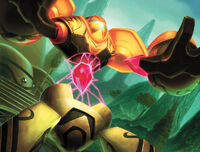
A blood elven Arcane guardian.
The blood elves' most common mount is the hawkstrider, a cockatrice-like creature that appears to be native to the forests of Quel'Thalas, found no-where else in Azeroth aside from in the blood elves' care. When Kael'thas led his followers to the ruined world of Outland, the vibrant hawkstriders that were brought with them proved to be welcome reminders of the blood elves’ beauteous home in Quel'Thalas. Valued for their trustworthiness and speed, these colorful avian creatures embody the inherent splendor of the forests within the blood elven kingdom. While tragedy has befallen Quel’Thalas in recent years, the hawkstriders remain an integral part of the elves’ day-to-day lives.[2]
Dragonhawks are another creature the blood elves have a positive relationship with. They have been used as flying mounts, and have battled alongside their elven masters in several conflicts.[42] The Farstriders mounted them for an aerial assault against the Scourge, and the blood elves would also employ this tactic against Arthas in Northrend - during both of their visits.[43]
The sin'dorei once had a natural affinity with the creatures of Eversong. The mana wyrms once served as guardians to the various crystals and arcane structures around the elven kingdom. However, they have since become maddened by the Scourge invasion, and the blood elves have even been seen to feed upon them. The lynxes and treants were also once allies of the elves, though without the ability to control the recalcitrant former and formerly cooperative latter, they have also become hostile in the wake of the Scourge attack. More recently, mana wyrms have been deployed by the blood elves on the Isle of Thunder, as a countermeasure against hostile magic-users.
Blood elves have been shown to keep cats around their cities and settlements, the proud and independent creature perhaps reflective of the blood elves' own attitude. In addition, blood elves have employed all manners of arcane-empowered indulgences, such as magical brooms to sweep the streets, crystals found all around Silvermoon, and flower ornaments found in magical levitation.
Constructs, inventions, and weaponry
The blood elves keep and control a large number of magically-imbued guardians to supplement their own guard force, named the Arcane Guardians. These hulking, robotic constructs serve as Silvermoon City's elite patrol force, with the ability to seek out and destroy enemies regardless of where they hide. They are also employed by the Blood Knight order, as seen with Gatewatcher Aendor and his ilk, and the Scryers have also created their own guardians. After the reclamation of the Sunwell, the Arcane Guardians have also been stationed around the holy font of power to assist the blood elven guard force there. It appears that these guardians were created during the reign of King Anasterian, though the quel'dorei had never been seen to make use of them prior to their conversion to sin'dorei.[44]
The Arcane Guardians have also been used as a propagandistic tool by the magisters, and will periodically remind citizens that the laws of Silvermoon must be obeyed, that Lor'themar Theron will lead them to power and glory, that Quel'Thalas will remain strong in the wake of Kael'thas' betrayal, and will openly encourage the citizens of Silvermoon to live their lives in happiness.[45]
In addition to the standard golems, the blood elves under Prince Kael'thas and Kil'jaeden created powerful alterations of the standard arcane guardian, dubbed the fel golems, towering constructs surging with fel power. The Sunreaver Onslaught further elaborated upon the fel golem design, creating new constructs (the Pyrestar Demolisher and the Haywire Sunreaver Construct) capable of more diverse and powerful abilities, sans the demonic input.
Furthermore, the blood elves have acquired the use of blood golems, formidable mechanical constructs forged in the Throne of Thunder, formerly under Lei Shen's command.
On Outland, the Sunfury blood elves created the mana bomb, an arcane-based weapon capable of great destruction. Both Kirin'Var Village and the Cenarion Thicket were wholly annihilated by the mana bombs' force, while another was procured for an attack on Theramore Isle; further empowered by the Focusing Iris, the bomb destroyed the entire isle. Tactical mana bombs have also been produced, albeit their volatile nature makes them ill-suited for use by rank-and-file soldiers.[46]
Floating crystals adorn several blood elven cities and outposts. These come in two flavors: the Burning Crystals (also referred to as "fel crystals" by Grand Magister Rommath), and the more standard Mana Crystals. The former is a device created by the Magisters to store demonic energy; in this state, several magi were seen to drain power from the crystals directly. They were once found around Quel'Thalas, though Rommath stated that they were removed after the Sunwell was restored.[47] The mana crystals (alternatively named the arcane crystals, defense crystals, or bloodgem crystals) are a more conventional creation (and implicitly the original form of the fel crystals), which can be used to scry, power defenses, strike at aerial enemies, and create magical shields over towns and outposts.
Blood elves and the Light
A key theme in the blood elven narrative is the Light's fall from grace in Thalassian society, and its subsequent revival following The Burning Crusade's finale. Most of the elves became disillusioned with the Light following the Third War, holding it in contempt for failing their homeland in its hour of greatest need.[48] With this mindset, the elves came to incorporate the notion of "bending" the Light to their will, and seeing themselves as its true masters as a result of this dominion: the other paladins of the world are forced to live by a strict moral doctrine when wielding the Light and its blessings, yet the Blood Knights had efficiently circumvented this by using Prince Kael'thas's teachings on the captured naaru, M'uru, siphoning his Light-given energy to fuel their paladin-esque abilities.

A cluster of Blood Crystals.
Now, the Blood Knights can freely channel the Light force they need from the restored Sunwell, the new fount of power a mixture of both holy and arcane energies.[12] Where this leaves the elves in relation to conventional Light worship is unclear, though at least some sin'dorei (the most prolific of which appear to be Lady Liadrin and her more vocal disciples) have rekindled a far more positive outlook on the Light.
Blood elven priests are more of a quandary, however, as comparatively little is known about their own outlooks on the Light. Some viewed the Blood Knights' opinion on the Light's abandonment as "folly," and continued to embrace it as priests and priestesses as the Light regardless of the new direction their society was heading in.[49] Sin'dorei priest trainers also refer to giving "sermons," a phrasing largely associated with holy blessings and, by extension, likely Light worship.
Relationships
The blood elves are a proud people, and as history has shown, they prefer to keep to their own company. Quel'Thalas enjoyed seclusion from the younger races for a long while, until both the Troll Wars and the Second War forced them into alliances with humanity. Despite this, Quel'Thalas was quick to abandon these ties on both counts, and went back into independent seclusion until the Scourge invasion - at which point, they began to actively seek new allies under Lor'themar Theron and Kael'thas Sunstrider's directive. They are currently members of the Horde.

A sin'dorei Blood Knight and a draenei mage, beyond the Dark Portal.
The sin'dorei have come to revile most races, yet the blood elves remaining on Azeroth have developed a relationship with the Forsaken due to Queen Sylvanas Windrunner, who was Ranger-general of Silvermoon until Arthas converted her into undeath against her will. The queen claims that she still considers herself one of the foremost protectors of Quel'Thalas. She has repeatedly offered assistance in the form of supplies and troops. The sin'dorei initially feared a trick, though ultimately relented and allowed Sylvanas to station Forsaken troops in the Ghostlands to help supplement the overstretched blood elven military fighting to secure it. Following this, Quel'Thalas and Undercity has developed something of a camaraderie, and an orb was constructed to allow quick travel between the two nations. The people of Quel'Thalas itself have seemingly come to view their former Ranger General as something of a hero, who gave her life to protect Silvermoon and continues to assist it in undeath.[50]
Ironically, Sylvanas' relationship with the blood elven regent Lor'themar Theron (her former second in command) and his Grand Magister does not appear to be particularly positive, and Sylvanas had to twist his arm with threats to see him dedicate troops to the Northrend war effort.[15] With the war behind them, Lor'themar and Sylvanas have become even more distant in recent times, the regent lord unsympathetic to her outlook around the other Horde leaders.

Valeera Sanguinar, a blood elf rogue, does battle with a draenei paladin.
Following the murderous actions of the bigoted Grand Marshal Garithos, the blood elves became more opposed to the notion of working with the Alliance than ever. Despite this, Quel'Thalas did engage in diplomatic relations with an Ironforge ambassador, though this did not end too well.[51] Certainly, the Alliance has shown no interest in helping the Azerothian blood elves either reach Outland or drive the Scourge out of Quel'Thalas. Already suspicious of the few scattered high elves who still exist, the Alliance considers the blood elves even less trustworthy. Night elves are particularly hostile toward blood elves: to night elves, the sin'dorei stink of desperation and arcane magic.[3] However, relationship with humans in general seems to have improved since the acceptance of blood elves in Dalaran and humans of Dalaran under Rhonin and Jaina Proudmoore until their neutrality was abused have defended the blood elves from their Alliance counter-parts and their high elven allies. Quest:The Fate of Dalaran Relations have improved enough that Lor'themar Theron, after facing the same bigotry from the Horde under Garrosh went into negotiations with King Varian and Stormwind to rejoin the Alliance as seen in Quest:What Had To Be Done. Even after Theramore's fall, despite tension, Jaina Proudmoore was still able to sympathize with the blood elves despite her new hatred for the Horde in Landfall.
The sin'dorei appear to hold little opinion on the dwarves. A number have raised their voices against Ironforge, even going so far as to state how the dwarves have "never been a friend" to Quel'Thalas. Rivalry between the sin'dorei and the dwarves regarding ancient artifacts has recently emerged, the Reliquary rising to counter the dwarven Explorer's League.
Magistrix Valthin, a blood elf mage.
The blood elves have a convoluted history with the draenei. Kael'thas's blood elven forces were responsible for the bewildered draenei fleeing Outland in the Exodar, and furthermore responsible for it crash landing into Azeroth. They later attempted to summon in reinforcements from Tempest Keep in order to conquer the Exodar completely and slaughter the remaining draenei. Prophet Velen, however, had seen a vision of what was to come - including the fate of M'uru, Lady Liadrin's plight, and Silvermoon City's future in the wake of Kael'thas' betrayal. Despite the grievances perpetrated by Kael'thas' blood elves against the draenei, Velen himself would be the one to reignite the Sunwell for the sin'dorei with M'uru's final spark. Despite their misgivings, the Shattered Sun Offensive (a coalition of the Aldor and the Scryers) showcased what the two races can do when of a like mind, as many of their intermingling NPCs attest.
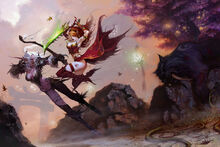
Sin'dorei vs Kaldorei.
A particularly bitter grudge lies between the blood elves and the night elves. Indeed, night elves regard blood elves with suspicion, disgust, or outright hostility,[27] while the blood elves in turn view their kaldorei cousins as savages.[52] Shortly after the magisters' return and the reclamation of Silvermoon, a night elven cadre entered Quel'Thalas to spy on the blood elves' activities, though were forcibly expelled. More recently, the blood elves have expressed an outrage at the return of the Highborne into the night elves' ranks, and are eager to see the trouble the new kaldorei magi will no doubt get themselves into. The sin'dorei have also assisted in removing the night elves from Azshara, eager to learn more of their highborne heritage with the kaldorei out of the picture.
The blood elves have a somewhat divided opinion on what remains of their high elven brethren. Some, such as Halduron Brightwing and Tae'thelan Bloodwatcher, have expressed no particular grudge or strong feelings towards the quel'dorei remnants; the former has referred to the elven race collectively as the "children of Silvermoon," while the latter has outright stated his intention to free the elves from their addiction, and unite them as the proud race they once were. Lor'themar Theron and Halduron have allowed them access to the Sunwell, though Lor'themar himself has also displayed some hostility towards some high elves such as Vereesa Windrunner, who had opposed the blood elves' inclusion into the Kirin Tor.
Many blood elves once had strong ties to Dalaran and the Kirin Tor, Prince Kael'thas himself having studied there and Grand Magister Rommath having once lived there. However, the Kirin Tor did not intervene when Grand Marshal Garithos sentenced the blood elves to an unjust death, leaving Rommath and his magisters to hold a strong hatred towards them for it. With the blood elven Archmage Aethas Sunreaver on the Council of Six, and existing members of the Six expressing a desire to reestablish good relations with the blood elves,[15] some sin'dorei have welcomed the ability to rejoin the Kirin Tor, though Rommath's disdain for this notion still persists. Archmage Athas holds a strong position in the Kirin Tor, whose followers (whom bear his namesake, the Sunreavers) have secured a large portion of the city of Dalaran for the blood elves and their allies' use.[53]. It appears Rommath's outlook on the Kirin Tor has been more prevalent in recent times, following the violent purge of the Horde from Dalaran.
Blood elves and the Horde
A sin'dorei warlock in the drapings of the Horde.
The vast majority of blood elves are now members of the Horde, this alliance conveying a strong clash of culture. The blood elves are a major part of the eastern Horde, along with their former Ranger-general Sylvanas Windrunner and the Forsaken. As relatively new members, the blood elves have sent several diplomats to various cities and leaders of the Horde (such as Ambassador Sunsorrow and Ambassador Dawnsinger), and diplomats of each Horde nation are found within Silvermoon City. Though the wider Horde was initially reluctant to forge allegiances with the sin'dorei, the vouching of Sylvanas, and the general consensus that the blood elves could bring to the table what the Horde had previously lacked,[54] would ultimately pave way to Quel'Thalas being accepted as an equal independent nation of the Horde.
Several blood elves prefer to keep with their own company, viewing their deployment outside of Quel'Thalas as something of a nuisance, though others have been seen to integrate fairly well into the wider Horde, even coming to appreciate its vastly different culture. [55] The blood elves were a major driving force in the Horde's Northrend campaign, Aethas Sunreaver ensuring them a vital sanctuary within the former Alliance city of Dalaran. A number of the sin'dorei have risen in the Horde's ranks, serving as generals [56] and as spy leaders.[57]
Some powerful blood elves have even been inducted into the Kor'kron Guard,[58] the most elite fighting force in the Horde's arsenal. The blood elven Reliquary is dedicated to giving the Horde a monopoly on artifacts of great power.
The relationship between the Darkspear tribe and the sin'dorei is a complicated one. Some blood elves (such as Paelarin) appear openly hostile to the trolls, going as far as to refuse them service despite their shared allegiance. On the other hand, Chieftain Vol'jin himself has a fairly amiable and respectful relationship with Ranger General Halduron Brightwing, perhaps born of their more moderate outlooks.
Leadership

Lor'themar Theron, a former commander of the Farstriders (and former second in command to Sylvanas Windrunner), rules the sin'dorei as the Regent Lord of Quel'Thalas.
Prior to the Third War, Quel'Thalas was ruled as an absolute monarchy, with High King Anasterian Sunstrider as the last high elven monarch. Anasterian's long rule, which lasted at least 3,000 years, was complemented by the Convocation of Silvermoon, a high council of elven lords who had vowed to assist the Sunstriders in keeping Quel'Thalas safe. However, during the Scourge onslaught, Anasterian himself was killed and the entire Convocation was eradicated - with only one surviving member, the traitor Dar'Khan Drathir, who was also put to the sword by Arthas following Quel'Thalas' fall.[59]
In the wake of the utter destruction of Quel'Thalas' leadership, Prince Kael'thas Sunstrider went on to become the sole leader of the newly named blood elves. Though still essentially a monarch, Kael'thas did not appear to officially take the elven crown, instead styling himself as the "Lord of the blood elves" and "The Sun King." Kael'thas decided not to revitalize the Convocation, and instead commanded Lor'themar Theron, the former second in command to Ranger General Sylvanas Windrunner, to act as Quel'Thalas' regent in Kael's physical absence from the elven homeland.
Ultimately, with the betrayal and death of Prince Kael'thas, Lor'themar has become the sole leader of the blood elven people. With the Sunstrider dynasty completely finished, the crown is unclaimed, and even Lor'themar himself has opted not to take it - or restore the Convocation - instead retaining his role as the "Regent Lord."[15]
As such, the blood elves are currently in a state of interregnum, with Regent Lord Lor'themar Theron as their sole leader.
The blood elves have a number of other leaders. Halduron Brightwing, the Ranger-general of Silvermoon, serves as the leader of the Farstriders and the blood elven military commander. Grand Magister Rommath presides over the magisters, the most magically-inclined and powerful spellcasters in sin'dorei society, while Lady Liadrin rules the Blood Knight order as its supreme leader and Matriarch.
Blood elf organizations
The sin'dorei have a number of organizations, mostly affiliated directly with Quel'Thalas.
Magisters

Magister Ashi.
- Main article: Magisters
One of the most prominent groups within Quel'Thalas, and a group whose magical formidability is considered fearsome by even Dalaran's standards[15], are the magisters. Led by Rommath, the Grand Magister of Quel'Thalas, the magisters are among the most respected and politically powerful groups in all of Quel'Thalas, and serves as Silvermoon's primary order of magi. They are directly responsible for the reclamation of the elven homeland from the Scourge, and it was their mastery over magic that enabled them to rebuild Silvermoon City "almost overnight." The magisters were able to twist even the energies of a naaru for the blood elves' use, leading to the creation of the Blood Knights. The various arcane structures around the city itself are empowered by their volatile magics, and the thought of what one of the most powerful magi organizations in Azeroth could bring to the Horde was a key component in the blood elves being accepted by it.[54]
The magisters have continued to wield a large amount of respect and political sway within Quel'Thalas, though whether their police state consensus persists despite the changes sweeping Quel'Thalas is unknown, if unlikely.
Farstriders
Jaedan Sunshot, a Farstrider.
- Main article: Farstriders
One of the most iconic elven organizations are the Farstriders. This elite organization of blood elf rangers can trace its roots back to the Troll Wars, when a loosely affiliated band of high elf warriors occasionally worked together to defend Quel'Thalas. Led by the Ranger-general of Silvermoon, Halduron Brightwing, they are perhaps the group most in touch with their high elven roots. Masters of the wilderness and many knowing their homeland inside and out, the Farstriders operate mostly in and around Quel'Thalas. Peerless marksmen and women, they are the masters of surgical strikes and ambushes. Though part of the blood elven government, they are not a formal military.[60] The Farstriders have long been considered valiant and honorable elves who regarded the law with deep respect and faith. Indeed, they have long been considered the epitome of selfless dedication.[60]
The Farstriders were against the creation of the Blood Knights, and Halduron himself vocally opposed the exploitation of M'uru. The two blood elven organizations do not generally get along too well.
Blood Knights

Crusader Farisa, a sin'dorei Blood Knight.
- Main article: Blood Knights
After the blood elves began to use more dubious methods of sating their addiction, a number of the elves felt the light abandon them. In turn, this led Lady Liadrin, a priestess of the light, to renounce her vows on the grounds that the light had forsaken the sin'dorei race. However, Prince Kael'thas would later subdue a being of pure light - a naaru named M'uru - and had it sent back to Quel'Thalas. Rather than feed upon its energy, the magisters devised a better use of its power - and after experimentation, they succeeded in allowing the blood elves to forcibly take their holy power from the supposedly unwilling being. Thus, the Blood Knights were born, under Liadrin's personal leadership. The will of the order would be tested when M'uru was stolen from Silvermoon, and the Blood Knights were left bereft of a power source. However, with the revitalization of the Sunwell, reborn as a fount of holy and arcane power, the Blood Knights of Silvermoon now channel their power directly from it - a far less damaging and more harmonious relationship than their previous method of wielding the light.[12]
The Blood Knights quickly gained popular support within Quel'Thalas, and their membership has since expanded. The Blood Knights serve as the iron protectors of Quel'Thalas, faithful servants of Silvermoon, and occasionally as state enforcers.[61] Their attitude is not received well by their Farstrider compatriots, and the two groups rarely see eye-to-eye.
The Sunreavers
- Main article: Sunreavers
Led by Archmage Aethas Sunreaver, the Sunreavers are a group of blood elves who desire to see the sin'dorei admitted as members of the Kirin Tor. Traditionally barred from Dalaran, the Horde was granted sanctuary in the city due to their efforts. Due to recent betrayals of the Kirin Tor from within the group, Jaina Proudmoore ordered them purged from Dalaran. This event led to the incarceration of Sunreaver civilians and those who were willing to surrender, and the demise of those who were not.
Sunreaver Onslaught
- Main article: Sunreaver Onslaught
Backed by Silvermoon and championed by regent lord Lor'themar himself, the Sunreavers who escaped the purge took up arms against Lei Shen and the Kirin Tor on the Isle of Thunder, with the goal of acquiring powerful leverage to secure the blood elves' future should Garrosh Hellscream's Horde fall to anarchy.
The Reliquary
- Main article: Reliquary
The Reliquary is an organization spearheaded by High Examiner Tae'thelan Bloodwatcher, and operates as a Horde counter to the Explorer's League. The Reliquary seeks to acquire artifacts of great power, and use them to free the elven race of the remains of their magical addiction completely.[62]
The Sunfury
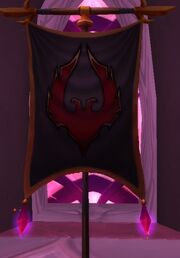
The Sunfury banner, a darker texture of its Silvermoon City equivalent, depicting the metaphorical phoenix of Quel'Thalas with two heads instead of one.
- Main article: Sunfury
The Sunfury were among the most powerful blood elves that Prince Kael'thas led into Outland. They numbered in the thousands.[63] They were situated mainly in the magic-rich area of Netherstorm, while other blood elves dispersed between the armies of the Scryers and Illidan Stormrage. Led by numerous generals such as Daellis Dawnstrike, a group attacked and slaughtered the local Kirin'Var Village and its residents, and other members of the Sunfury saw to the dismantling of the manaforges in the area for their master's gain. They also acquired numerous bloodgem shards, which they channelled into bloodgem crystals for a temporary empowerment. The Sunfury were one of the more ruthless sects of blood elves found in Outland.
Following the betrayal of Kael'thas, however, a number of the Sunfury returned home to serve their people rather than follow Kael's increasingly damning path, thus affiliating themselves with Quel'Thalas and the Horde.[15]
Though now an official part of Silvermoon's military, the Sunfury have made only a minor appearance in World of Warcraft in such an incarnation.
The Scryers
- Main article: The Scryers
The Scryers were once high ranking blood elves in Prince Kael'thas's army, their ranks including some of the most gifted scholars and magisters that Kael had led into Outland. They are led by Voren'thal the Seer, a magus of considerable prowess and age.[64] Voren'thal grew increasingly troubled by the dark path his prince was treading, and was granted visions of the naaru, A'dal. Believing that the Sin'dorei's only chance for survival rested with the naaru, Voren'thal and his followers chose to abandon Kael's cause.
Voren'thal and his forces were ordered to attack Shattrath City, though threw down their weapons and requested an audience with A'dal instead. Voren'thal pledged his forces to Shattrath's cause, a defection that vexed Kael'thas—now bereft of some of his strongest followers—greatly. Now known as the Scryers, Voren'thal and his followers were granted a portion of the city to call their own, which became known as the Scryer's Tier. Though sponsored by the city's naaru hosts, the Scryers' draenei counterparts, the Aldor, did not take kindly to the Scryers' presence in the city; a factional divide quickly broke out between the two.
The Scryers sought to save their people from Kael's downfall, and uncovered concrete evidence that the prince had began consorting with the Burning Legion.[65] Following Kael's defeat in Tempest Keep, Scryer forces returned home to Quel'Thalas under the banner of the Shattered Sun Offensive (a coalition of Aldor and Scryers banding together) to end Kael's ambitions for good.
What became of the Scryers following the demise of Kael'thas, the defeat of Kil'Jaeden, and the restoration of the Sunwell is unclear.
Others
Notable blood elf organizations affiliated elsewhere (with Kael'thas, Illidan or the Burning Legion) include the Eclipsion, the Sunseekers, the Shadowsword, the Sunhawks, the Sunblade, the Dawnblade, the Crimson Hand, and the Firewing blood elves.
A small organization named the Blood Hawks serves Quel'Thalas from Eversong, and its leadership reports directly to Ranger General Halduron.[51]
Notable blood elves
Ancestry and offshoots
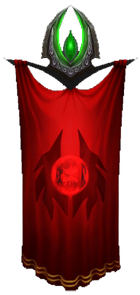
The San'layn banner, an altered version of the sin'dorei original.
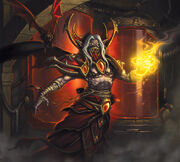
Prince Tenris Mirkblood, one of the first Darkfallen
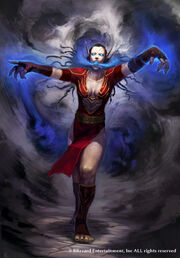
A female wretched
The blood elves of today descended from the night elves. Though the sin'dorei style themselves as having been "reborn" from the ashes of the shattered quel'dorei, in biological essence the two groups belong to the same race.[3] Blood elves are the hosts of several other newly-emerged races, each stemming from sin'dorei roots as the sin'dorei did from the kaldorei - though not by conventional means:
- The Wretched - If a sin'dorei fails to control their addiction, they will often succumb to the thralls of it and gorge themselves excessively on power without thought for constraint. Physically warped from their elven appearance, this savage sin'dorei offshoot represents itself via a primal form of "society" and serves as a warning to the blood elves - if their magical addiction is not controlled, then this pitiful fate may await them. Though generally disorganized, some followed Kael'thas Sunstrider to the Isle of Quel'Danas, where the last of them were put to the sword. Ironically, Kael'thas himself would end up a wretched. Recently, the quel'dorei have also produced a Wretched offshoot.
- The Felblood elves - The felblood elves are a blood elf offshoot who, like the orcs before them, have been corrupted by the Burning Legion. After returning to Azeroth with the corrupted Prince Kael'thas, these loyal remnants of his army were allowed to gorge themselves on colossal amounts of demon blood. The felblood elves haves taken on various demonic traits, among them black wings, a reddish skin color, and horns. Though far more formidable combatants than the relatively small amount of Wretched, the felblood elves have been seen to covet fel energies all the same, channeling it and indulging themselves without fear of repercussion. Their forces and their one major organization were defeated in the Sunwell Plateau.
- The Darkfallen - Following Kael'thas' ill-fated attack on Northrend with Illidan Stormrage, several of his followers were killed in the ensuing chaos, including the wielder of Quel'Delar, Lana'thel. Arthas later raised them into his service, and they were dubbed the "Darkfallen." These powerful undead blood elves served highly in the Scourge's ranks, several of which were to form the San'layn under none other than Lana'thel's leadership, Lanathel herself now a hulking, elegant vampiric "Blood Queen." Like the blood elves' need to feed on magic, several Darkfallen displayed the need to feed on - or at least a hunger for - blood itself, reflecting their vampiric nature. The Darkfallen were killed in Icecrown Citadel and the bulk of their leadership dismantled, though one or two members of the San'layn still remain unaccounted for.
Alignment
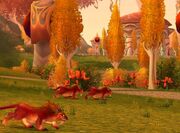
The blood elf starting area, Sunstrider Isle.
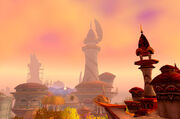
In the December 2005 issue of Computer Gaming World, Metzen had said blood elves are not an evil race.[66]
Tensions from the aftermath of the Second War have become burning hatreds. The high elves officially withdrew from the Alliance after the Second War under the belief that not enough troops were sent to protect Quel'Thalas, and thus led to a needlessly engorged amount of slaughter and destruction. A few high elves remained under their own volition to continue serving the Alliance, but the loyalty of even these voluntary troops waned after the second sacking of Quel'Thalas by Arthas — who had recently destroyed his own kingdom — to which the remnants of the Alliance of Lordaeron took no steps in intervening. Finally, with Lord Garithos's dismissive, blatantly racist treatment of blood elven troops and attempt to execute many blood elves for accepting boats from naga, even more fell under the sway of Kael'thas' new vision for his people.
As a result, blood elves are fierce jingoists, believing that the only people they can truly trust are their own. They are perceived as reckless and haughty, exhibiting none of the serenity or calm judgment of their ancestral peoples, and jumping at opportunity and quick solutions with little regard for the consequences. They believe power is not something to be earned — it is to be taken. Power is something to be manipulated for yourself and the greater good of all blood elves. This reasoning also plays into how the blood elves successfully drained pure Light energy from the naaru to become Blood Knights, and paying no interest to the paladin credos of benevolence or balance with the universe (although regular paladins can unknowingly be corrupt).[citation needed] This may have changed with the Blood Knights' introduction to the Shattered Sun Offensive, however.
Indeed, one can even argue that — while they officially are a monarchy undergoing an interregnum — the blood elves border on being a fascist state. Their contempt for other races and feelings of superiority to them, their aggressive use of propaganda (such as the Arcane Guardians promoting a messianic view of first Kael'thas and then Lor'themar) and mind-control (such as the silencing of the dissidents in the Silvermoon City Bazaar), and their general "us against the world" attitude all are hallmarks of historical real-world fascist governments. Even their general feeling of putting up with the "inferior" races of the Horde as long as it suits their purposes recalls such events as Nazi Germany partnering with the Japanese Empire during World War II, even though it went against their racial theories of Aryan superiority. Only time will tell whether continued cooperation with and exposure to the other Horde races and their philosophies will begin to change the blood elves' view of the world and their place in it.
The official World of Warcraft: The Burning Crusade webpage mentions blood elves having a "dark destiny".[67] This likely refers to the fact that blood elves under Kael'thas had joined with the Burning Legion, under the demonic Illidan and the naga. This likely is not in reference to the majority of blood elves who were left on Azeroth who do not know about Kael'thas' decision. Indeed, many of those back on Azeroth chose to turn against Kael'thas when they learned of it.[68] A large faction of blood elves previously under the direct command of Kael'thas defected, and are now known as the Scryers, and currently operate to fight against the prince.
Speculation
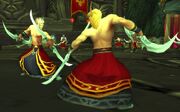
Illidari Demon Hunter training on top of the Ruins of Karabor
This article or section includes speculation, observations or opinions possibly supported by lore or by Blizzard officials. It should not be taken as representing official lore.
|
Fel-power vs arcane magic
An interesting point made in wider supplementary material (notably the Warcraft Encyclopedia) is that most blood elves in Quel'Thalas were trained by Grand Magister Rommath purely in the art of taking arcane magic from external sources, yet never demons; the only sin'dorei fully aware of Prince Kael'thas' demonic dealings with Illidan Stormrage—the progenitor of these radical techniques—were the ones on Outland, and they alone were becoming convinced of its necessity while their brethren in Azeroth sated themselves purely on lesser magic, such as "small mana-bearing creatures."[3] and that most sin'dorei in Quel'Thalas would likely be horrified if they realized the true nature of their prince's dealings with Illidan. Exactly how the fel-induced green eye glint could become widespread is thus curious.
- One logical possibility lies with the (even now, enigmatic) burning crystals found around Quel'Thalas, which, while not openly addressed in-game, are hinted to bear a degree of arcane energy. It could be that the general blood elf populace were given free access to these crystals, though this is not seen in-game (in fact, only magisters have been seen to drain power from the crystals; other sin'dorei make references to using "mana crystals" or simply draining arcane magic elsewhere instead), and seems contradictory to the above statement. Furthermore, it was stated in the very first quest on Sunstrider Isle that said crystals had always been empowering Quel'Thalas, long before the Scourge invasion.
- A more likely possibility lies in the sheer nature of demonic power, as witnessed with the orcs: even the orcs who did not engage in the drinking of Mannoroth's blood were afflicted by the side-effects by mere proximity to those who had. It seems highly likely that this had occurred in Quel'Thalas—the green eye glint passing by mere proximity to those who were actively dabbling in fel-power.
- Another reason could be that draining arcane magic itself was behind the eye glint, as the mere practice of "bathing" in the freely-given arcane magic of the Sunwell could have proved a vastly different process than actively draining it to sustain you.

Grand Magister Rommath at the restored Sunwell.
- It is equally possible that some aspects of all of the above were present.
Following the restoration of the Sunwell, the draining of arcane magic is no longer needed (or encouraged).[2] The blood elves are instead urged by their leadership to turn to the Sunwell to sate their addiction in a more healthy and more harmonious manner,[2] though a few are yet hesitant to abandon their "dependence on arcane magic."
With the recent developments at the Sunwell, the demise of the demonically-twisted Prince Kael'thas, and the newly-taboo nature of draining arcane magic instead of using the Sunwell to bathe in it, it seems likely that fel-power is more taboo than ever in sin'dorei society, if not outright outlawed. It was stated that the monumental events that transpired at the Sunwell may take some time to be properly painted in-game, though it is possible that Quel'Thalas itself may someday be updated to better convey some of these massive changes sweeping blood elf society.
This query was addressed in the third round of Ask CDev:
- How did the blood elven fel eye glint become so widespread? The Warcraft Encyclopedia suggests that Rommath only taught the blood elves of Azeroth about how to siphon arcane magic, as most of the populace would likely be "horrified" if they knew the true extent of Kael’s dealings with Illidan.
- The situation regarding blood elf eyes is, in fact, extremely similar to that of the green skin of orcs: just being around heavy use of fel magic turned the eyes of the blood elves green. You could be the most pious of priests or most outdoorsy of Farstriders, chances are, if you were a high elf in Quel’Thalas or Outland following the Third War, you were around fel energies, and your eyes would turn green. Like the orcs’ skin color, such an effect would take a very long time to wear off. Fel magic works a bit like radiation in this sense; it permeates the area and seeps into anything in the vicinity. Anything near a source of fel magic shows signs of slight corruption, it just so happens that high elves and orcs manifest it in a very visual way.
Blood elven societal future
Creative development Vice President Chris Metzen was once asked about the aforementioned changes to sin'dorei society, and what the future may hold for the blood elves with their Sunwell restored. Below is a transcript:
- Q: What's happening to Blood Elf culture (especially Rommath's role in it) now that the Sunwell was restored with M'uru?
- A: What we showed at the end of Burning Crusade, like during the whole Sunwell event, was that the warped naaru M'uru was kinda transformed back into his purest self, purest light that Velen used to reignite the Sunwell, as a fountain of Holy power, as much as it is arcane. So the suggestion was that over time the Blood Elves will start to actually use real Light power, in a healthy way, instead of dominating it. So what will likely happen over time is a slow transition, but what Velen did was give them a chance to redeem their civilization, a chance to get back to their roots, a chance to upset their magical addiction. So that kinda thing will probably gonna play out very slowly. We didn't talk much about it in Wrath of the Lich King, but it is a theme I love a lot, but it has to be played out very slow.[69]
The implication seems to be that the changes induced by the restored Sunwell will be for the betterment of Quel'Thalas (as noted on the blood elves' official race page)[2] though may take some time to be fully explored. More recent (post-Cataclysm) interviews broaching the subject have been met with similar responses, as well as the knowledge that both the blood elves and their fellow The Burning Crusade race, the draenei, will receive considerably more input (along with a more overarching storyline) in the not-too-distant future.
Elven reunification?

With the banishment of Kil'jaeden and the restoration of the Sunwell, one could argue that the blood elves have in effect been restored to high elves or could return to being high elves. The elves no longer have to turn to arcane magic to feed their addiction, and ultimately it is simply a matter of time before the physical fel-power side effects retract - hinting at the possibility of reconciliation.
At this point, however, there are many cultural differences between the high elves and the blood elves, and there are probably only a handful of blood elves who would even choose to revert. On the flip side, some of the existing high elves have expressed a disdain for the methods some sin'dorei dabbled in in order to reclaim Quel'Thalas and fight off their addiction. This was hinted at with Wrath of the Lich King, where in Dalaran, a faction of high elves, the Silver Covenant, stand as direct opposition of the the Sunreaver blood elves in Dalaran despite the fact that with the Sunwell's return the blood elves no longer have to consume arcane (or fel) energies.
Despite this opposition, some blood elves continue to hold the desire to unify their once glorious race. A prime example of this mindset is Tae'thelan Bloodwatcher, the leader of the Reliquary. His goal to cure the elves of their addiction for good, through controlled methods, combined with the Sin'dorei allowing their cousins access to the Sunwell, could see the already small gap between the two sides of the Silvermoon coin become even smaller. This has been somewhat elaborated upon in recent times, as even Vereesa Windrunner herself - the leader of the aforementioned Silver Covenant, the faction who opposed the blood elves more than any - was willing to travel to Quel'Thalas at Halduron Brightwing's request, to fight alongside both he and another leader of the Horde, the Darkspear troll Vol'jin. Furthermore, Lor'themar Theron has allowed high elves to enter the restored Sunwell, though he and Vereesa appear to have some bad blood between them.
Inspiration
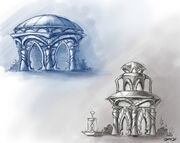
Concept art of blood elven buildings.
- The name sin'dorei may be a reference to Sindarin, the elvish language most commonly spoken in Middle-Earth during the Third Age in the Tolkien mythos. This, however, may not be the reference since sin'dorei comes from the names of the other types of elves in Warcraft, though it could have had an effect. Though it is improbable, some think that "sin" comes from the English word sin, and "dorei" from the kaldorei, the night elves.
Notes and trivia
- "Silvermoon" Harry appears to be one of the biggest blood elf fans on Azeroth.
- The RPG seeded the idea of blood elves bearing runic tattoos to ward off demons, and early blood elf artwork depicted them with such. The idea seemed to have been dropped by the time they were made playable in World of Warcraft; neither the playable faction in Silvermoon nor Kael's elves on Outland are seen sporting any tattoos. The sole exception seems to be Grand Magister Rommath, whose unique model appears to depict him with runic tattoos on his arms, though it's unclear as to whether it's a tattoo or a part of his clothing.
- As a visual cue, blood elves are almost always depicted with green eyes in World of Warcraft, though exceptions exist. Blood elf death knights (who are unaffected by magical addiction and many, like Koltira, would not have been active in Quel'Thalas anyway when fel power was being used) have regular blue eyes beneath their glowing, icy death knight eyes.
In the RPG
Languages
Blood elves speak Thalassian, the age-old language of their ancient race, and have learned the languages of their allies.[5][70]
Classes
Many blood elves are warlocks or mages, though some become hunters, scouts, or warriors — especially those seeking to be spell breakers, demon hunters, and rangers.[5] A few continue to draw power from the Light and remain priests. Some blood elves take their demonic obsession one step further and become felsworn,[5] while others choose to draw on the magic of the Legion and become blood mages.
Other relationships
While they hate most races, they have come to accept the Forsaken, as they share the same goals.[68] The western Horde recognizes the blood elves as dangerous, volatile and ultimately destructive.[71] The Horde orcs, Darkspear trolls and tauren distrust the blood elves, as their addiction to magic makes the high elves look like amateurs. In particular, the orcs revile the blood elves because they see them as descending down the same path toward damnation that so corrupted the orcish people — the orcs can smell the demon taint on the blood elves and know how badly it will twist them. The blood elves consider the Horde to be barbarians who refuse to grasp power in front of them. They especially dislike the orcs, who should have been strong enough to control the power the demons gave them instead of falling under their command.[72] Blood elves reek of fel power, offending the spiritual senses of night elves and tauren.[5]
Blood elves feel betrayed by the Alliance and are enemies of both humanity and the night elves. The blood elves try to draw the remaining high elves into their fold — a concept the goodly high elves view with horror and revulsion. Indeed, the existence of the blood elves demonstrates the depth of the corruption possible for this once mighty race, and the high elves see them as a dire warning. Many high elves seek to make amends for evils wrought by their demented kin. Blood elves get along well with the naga — with whom they share Highborne ancestry — and other independent factions. They are not welcome in Alliance lands.[71] The Alliance represents all that the blood elves hate in the world. The humans led the Exodus from Lordaeron, abandoning the blood elves to the Scourge, taking many high elves with them. The high elves are weak; they have potential to reach blood elf status, but they will not embrace the power and therefore are of little use. The night elves are remembered as the elves who banished them from their homes so very long ago, and those grudges still run deep. The other races are disliked merely for their representation in the Alliance — the friend of my enemy is my enemy, so to speak. The Alliance view them as dangerous (and mad, in some cases). The arcane spellcasters in the Alliance agree that the blood elves have gone too far in their quest for power — even the high elves are sickened and frightened by their former brethren's loss of compassion and self-control. The blood elves have little use for the Alliance, and the downfall of this faction is next on their list after they have purged the Scourge from Lordaeron.[73]
The blood elves consider the naga their allies and friends. The other neutral races that interest them are the goblins and some of dark trolls. The goblins are the only merchants who will sell to the blood elves without prejudice; if an Alliance or Horde merchant would even allow a blood elf to look at her goods, she would most certainly raise the prices astronomically. The troll tribes often have items or information of use to the blood elves, and they hate the night elves with almost the same passion. The blood elves have few opinions on the other independent races — those that worship a divine power are weaklings, and those that remain neutral are of little consequence.[73]
Many blood elves have insinuated their way back into the world and seek out places rich in magical power — such as Ashenvale Forest. Some blood elves, steeped so thick in pain and anger, have joined the Shadow Council in Felwood.[71]
Evolution from high elves?
Blood elves between the Third War and World of Warcraft were physically identical to high elves, save that they dressed primarily in blacks and reds to remind themselves of their terrible losses. Many painted runes or mysterious tattoos on their faces, arms and shoulders for warding off demons or celebrating significant kills or simply to look intimidating — something high elves would never do. As well, they adopted hair styles that went against the norms of high elf society.[71] Nevertheless when approaching Alliance towns blood elves would often disguise themselves as high elves to avoid harm.[73]
Separated more by cultural differences than physiological ones, it has since been determined that they are, in fact, beginning to evolve into a separate race, due largely to their consumption of mana from primarily fel sources.[74][75] This reliance on fel magic causes the eyes of blood elves to glow green with demonic fire.[68] This readily available source of energy also tends to give blood elves a ruddier or paler look compared to their quel'dorei cousins. A blood elf can appear like a high elf bearing odd red tattoos across his or her face and arms. However, his or her hair and skin is much paler than that of a high elf, their eyes glint with a green light, and they wear blood-red robes.[68] These represent signs of evolution from their high elven cousins, and it is believed that, with time, they may become as physically distant to high elves as satyrs are to night elves.[68]
Notes
- According to the (non-canon) roleplaying guide, blood elves as a whole are classified as the "neutral" alignment.[68]
Names
As seen with most blood elves who survived the Third War, the sin'dorei have (for the most part) retained their quel'dorei names. As such, the same naming rules are typical of their high elven cousins. The high and blood elves share a connection with the sun that is quite prevalent in their choice of family names.[76]
- Male Names: Mariel, Athaniar, Anandor, Tharama, Viridiel, Malanior.[76]
- Female Names: Anarial, Freja, Driana, Coria, Alanassori, Melanion, Azshara.[76]
- Family Names: Boughstrider, Dawnblade, Lightbringer, Morningray, Suntreader.[76]
Unlike the high elves, however, a number of blood elves have taken on more aggressive surnames - often incorporating the word "blood" into their identity, which had not been heard of prior to the sin'dorei coming to power. Presumably, this is to better illustrate their cultural identity and their drive for vengeance, as many blood elves would have lost family members during the Scourge massacre. This is particularly prevalent within the Blood Knight order, which displays a number of members bearing the term - Bloodvalor, Bloodsworn, Bloodwrath, among others. A number of blood elven ranks, titles and organization names have been fashioned to better convey this, such as "Blood Lord" and "Blood mage", and indeed, the term "Blood Knight" itself. [citation needed]
Alignment
Most blood elves are not insane or evil—they just choose to fight fire with fire. They are suffering due to the loss of their precious Sunwell; they all needed—and still need—to feed on arcane energies, even though most of them aren't spellcasters. The most powerful blood elf spellcasters are insane, as the magic they wield is corrupting.[77] Farstriders is one of the few groups that still have any of these virtues.[78]
See also
- Blood elf (playable)
- Rise of the Blood Elves, from the History of Warcraft
- History of the blood elves
- Blood elf units in Warcraft III
- Blood elf controversy, documenting the controversy preceding the introduction of the blood elves with the Burning Crusade expansion
References
- ^ a b c d Blood of the Highborne
- ^ a b c d e f g h i j k l Races of World of Warcraft: Blood Elves
- ^ a b c d e f g h i j k l The Warcraft Encyclopedia: Blood Elves
- ^ Arthas: Rise of the Lich King, 88
- ^ a b c d e Monster Guide, pg. 65
- ^ a b http://www.youtube.com/watch?v=NE-4Edh3RuM 5:02 Burning Crusade Behind the Scenes DVD
- ^ World of Warcraft: The Burning Crusade manual, pg. 12-13
- ^ Blizzard lore posts
- ^ Ask CDev Answers - Round 3
- ^ a b c Wrath of the Lich King manual, pages 8-9: Winds of Change: From Dark Horizons to a Beacon of Hope in the World of Warcraft
- ^
 [Letter from Lor'themar Theron]
[Letter from Lor'themar Theron]
- ^ a b c Ask CDev Answers - Round 1
- ^ Foreman Sundown
- ^ Quest:Crush the Dawnblade
- ^ a b c d e f g In the Shadow of the Sun
- ^ Post-Cataclysm Blood Elf Introduction
- ^ Lady_Liadrin#The_Path_to_Redemption
- ^ a b c d Ask CDev Answers - Round 2
- ^ Quest:Avenge Furien!
- ^ Quest:Pain of the Blood Elves
- ^ Quest:The Assault on Zeb'tula
- ^ Quest:Tear Down This Wall! (Horde)
- ^ Quest:To the Skies! (Horde)
- ^ Quest:The Fall of Shan Bu (Horde)
- ^ Quest:Life Blood
- ^ BlizzCon 2013 - The Adventure Continues panel (44:10-46:02)
- ^ a b c The Warcraft Encyclopedia: High Elves and Blood Elves
- ^ World of Warcraft: Official Beginner's Guide, 39
- ^ Tides of Darkness
- ^ Thrall: Twilight of the Aspects, 73
- ^ http://sonsofthestorm.com/viewer.php?artist=redknuckle&cat=warcraft&art=1
- ^ http://us.battle.net/wow/en/media/artwork/trading-card-game/series5?view=tcg-series5-034
- ^ http://us.battle.net/wow/en/media/artwork/trading-card-game/series8?view=tcg-series8-080
- ^ Tyrus Sheynathren
- ^ Arthas: Rise of the Lich King, pg 346
- ^ Arthas: Rise of the Lich King, pg 364
- ^ http://pc.gamespy.com/pc/world-of-warcraft-expansion/662489p1.html
- ^ Sean Copeland on Twitter, RE: Spellbreakers
- ^ "Forever after, they would embrace the sun and be known only as the high elves. " - Exile of the High Elves. History of Warcraft, Chapter 1. Retrieved on 2010-11-30.
- ^ TCG Fires of Outland/17 "The light sustains us, and it will ease even the heaviest of burdens. To think it has abandoned us is pure folly."
- ^ Arthas: Rise of the Lich King, 364
- ^ Arthas: Rise of the Lich King
- ^ Orgrim's Hammer Scout
- ^ Quest:Major Malfunction
- ^ Arcane Guardian
- ^ Quest:Tactical Mana Bombs (Horde)
- ^ Quest:What's in the Box? Rommath's gossip text
- ^ Burning Crusade Behind The Scenes - Blood Elves. YouTube (2008-03-19).
- ^ TCG Fires of Outland/17 "The light sustains us, and it will ease even the heaviest of burdens. To think it has abandoned us is pure folly."
- ^ Vaeron Kormar
- ^ a b Quest:The Dwarven Spy
- ^ Melaya Tassier
- ^ Sunreaver's Sanctuary
- ^ a b Horde Emissaries
- ^ Lorrin Foxfire
- ^ General Salaman
- ^ Spy-Mistress Anara
- ^ http://www.wowhead.com/npc=37035/korkron-vanquisher#abilities
- ^ Arthas: Rise of the Lich King, 295
- ^ a b The Warcraft Encyclopedia: Farstriders
- ^ Gatewatcher Aendor
- ^ High Examiner Tae'thelan Bloodwatcher
- ^ Excerpts from the Journal of Archmage Vargoth
- ^ Quest:Bound for Glory
- ^ Quest:Damning Evidence
- ^ [1]. Computer Gaming World, December 2005
- ^ http://www.worldofwarcraft.com/burningcrusade/townhall/index.html
- ^ a b c d e f Monster Guide, pg. 64
- ^ http://www.blizzplanet.com/blog/comments/chris_metzen_micky_neilson_pocket_star_books_lore_qa_video_interview
- ^ Alliance & Horde Compendium, pg. 16
- ^ a b c d Alliance & Horde Compendium, pg. 15
- ^ Alliance & Horde Compendium, pg. 68-69
- ^ a b c Alliance & Horde Compendium, pg. 68
- ^ Alliance & Horde Compendium, pg. 6-7, 14-15, 67-69
- ^ Monster Guide, pg. 54-55
- ^ a b c d World of Warcraft: The Roleplaying Game, 37
- ^ Monster Guide, pg. 64-65
- ^ Dark Factions, pg. 152
External links
 World of Warcraft Community Site The Warcraft Encyclopedia - Blood Elves
World of Warcraft Community Site The Warcraft Encyclopedia - Blood Elves World of Warcraft Community Site Official Burning Crusade Flash Site
World of Warcraft Community Site Official Burning Crusade Flash Site
| |||||||||||||||||||||||||||||||||||
da:Blood elves de:Blutelf lt:Blood Elf lv:Asins elfi hu:Vérelf nl:Blood elf ru:Эльф крови fi:Blood Elf ja:Blood Elf

